Physical Address
304 North Cardinal St.
Dorchester Center, MA 02124
![]()
![]() Access video and video lecture content for this chapter online at Elsevier eBooks+
Access video and video lecture content for this chapter online at Elsevier eBooks+
A facial rejuvenation procedure attempts to restore an aging face’s lost youth, by surgical or non-surgical means. Rhytidectomy is without any doubt the most established facial rejuvenation procedure today. This procedure has evolved substantially in the past five decades, since the superficial musculoaponeurotic system (SMAS) was introduced by Mitz and Peyronie in the mid 1970s. Numerous methods and concepts have been proposed and practiced, such as SMAS plication, excision or suspension, deep plane, endoscopic lifting, etc. In the 1990s, short scar rhytidectomy regained popularity.
The purpose of the minimal access cranial suspension (MACS) lift was to make rhytidectomy safer and simpler, while maintaining a powerful but natural-looking result. The MACS lift concept was gradually developed in the late 1990s and first published in 2002. Since then, this procedure has become well accepted worldwide. We (P.T., A.V.) now have more than 20 years of experience in performing this procedure, and we have made no substantial changes in the surgical technique. The real change came from the better understanding of the facial aging process, and consequently adding ancillary scientifically based procedures to our original MACS lift surgery, mainly for midface rejuvenation, such as lipofilling, and a more radical result in the lower neck in selected cases.
It is a common mistake to see facial rejuvenation as an isolated procedure. Facial aging is a very complex multifactorial process that involves sagging, volume loss, and skin structural changes of different facial organs and aesthetic units. Consequently, a comprehensive facial rejuvenation procedure should address all the different aging processes in order to maintain a harmonious outcome. Failure to consider the many factors contributing to facial aging and address them in the rejuvenation process will result in the inability to restore a natural appearance of youth, and will lead to less than ideal results.
Our notion of facial rejuvenation, therefore, is comprised of two key elements: We adopt a holistic approach to facial rejuvenation, that addresses sagging, volume changes, and skin quality of all facial components, in order to restore all age-related facial deformities rather than change them. For a detailed description of the ageing process see Chapter 9.2 .
Aging is the result of the orchestrated interplay of changes occurring in the facial organs such as skeleton, ligaments, muscles, adipose tissue, and skin. These changes appear in each mentioned structure at a different timing and pace, and develop at a different age for each individual, and differ between ethnic backgrounds.
The ability to pinpoint the changes that take place over time responsible for the apparent age-related changes, and appreciating the underlying anatomic factors responsible for them, is essential for appropriate planning of the rejuvenation procedures. In most patients, we consider the three main features of facial aging:
Tissue sagging, and loss of youthful facial contour
Loss of facial volume
Structural changes of the skin surface.
Understanding the difference between facial sagging and facial deflation is imperative. Facial sagging occurs in the periphery of the face – lateral to the lateral canthus and mouth commissure and continues in the neck, and results in jowling and loss of jawline definition. Facial deflation takes place mainly in the center of the face, where most mimic musculature and movements are present, such as the periorbital region, the malar area, and the perioral area. Skin structural changes are the superficial changes in the face and neck skin quality (e.g. texture, wrinkles, pigmentation) and are independent of both sagging and deflation processes ( Fig. 9.4.1 ).
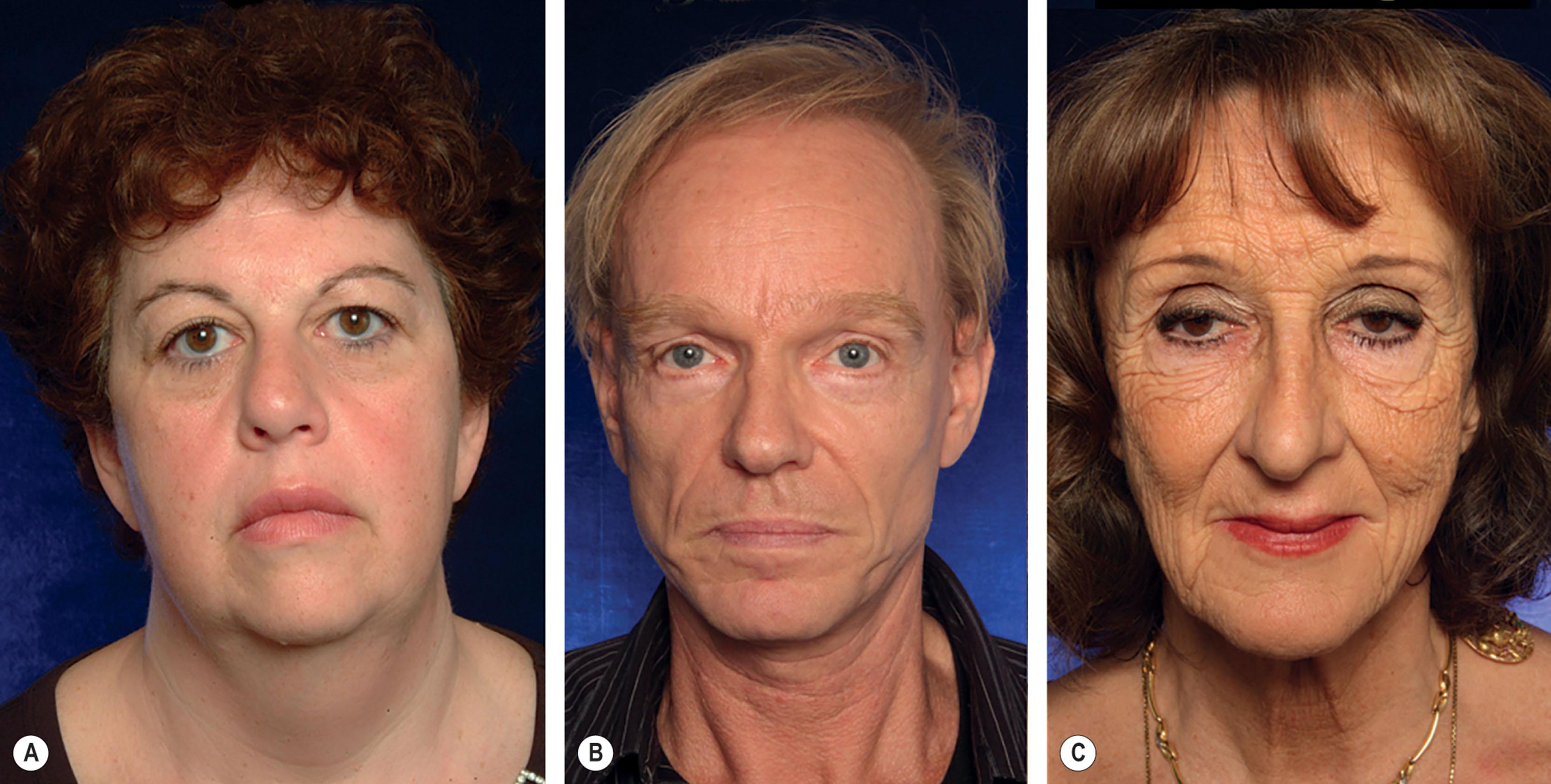
Whereas the lateral face aging process has been well understood in the last five decades, understanding of the aging process of the central face has been more elusive, and real progress was made in the past 20 years.
The center of the face consists of three main zones: forehead and periorbital area, the anterior midface, and the perioral area. While a facelift procedure mostly affects the lateral face and neck, it has only a limited influence on central face. Therefore, our ancillary centrofacial strategies (augmentation blepharoplasty, midfacial and perioral lipofilling, etc.) aim to restore the youthful appearance of this oval-shaped area of the anterior face.
Gravity alone cannot explain why the midface soft tissues retrude posteriorly with age. The current perspective is that centrofacial aging is more a result of deflation then sagging. Lambros made observations on facial photographs taken 10–50 years apart. Careful analysis of the changes revealed that orbicularis wrinkles and midfacial scars and moles did not appear to move inferiorly to explain changes in shape, at least in the upper midface.
Clinical findings reveal that the majority of deflation in the face occurs in areas that are mobile, as a result of facial muscles movement. As most of the mimic muscle activity occurs in the central part of the face and the temporal, these are the facial areas most subject to deflation.
Deep facial grooves are mainly present in areas of repeated facial animation such as the frontal and glabellar grooves, crow's feet, orbitomalar groove, the nasolabial fold, and labiomental groove. These grooves become deeper and permanent over time. Based on those observations, we introduced the hinge hypothesis. We hypothesized that facial fat atrophy could be influenced by a mechanical factor. Repetitive movements due to mimic activity could result in long-term loss of fat tissue.
As we age, the osseous structures of the midface collapse. The maxilla and inferior orbital rim are subject to bony resorption. The anterior wall of the maxilla consistently retrudes as we age and the anterior cheek mass becomes less prominent with age. This bony structure serves as a foundation to the overlying soft tissue, and its resorption results in a loss of anterior projection.
Apart from the changes in the bony structure, attenuation of facial ligaments alone would be insufficient to explain the changes in fat compartments and aging of the face. Volume loss in the midface soft tissue is a fundamental part of the aging process. Fat compartments in the face can change at different rates with age, hence the whole face does not age as a compound mass. Deflation of the deep midfacial fat may dramatically effect midfacial aging. This decreases support for the medial cheek compartment and results in diminished midface projection and unmasks the nasolabial fold. It was shown that volume loss of the deep medial cheek fat leads to pseudoptosis. Augmentation of this fat pad results in increased anterior projection that cannot be addressed by a lateral lifting procedure alone.
The periorbital area and, in particular, the eyes and its close surroundings, serve as the focal point of the face and are considered the most important feature of facial expression. The perception of age is focused primarily on this area, especially the brow and lower eyelid region.
The upper eyelid undergoes three types of age-related changes: dermatochalasis, blepharoptosis, and fat atrophy. When analyzing patients’ pictures taken at a younger age, they nearly always reveal a certain degree of volume loss in the upper eyelid, especially in the medial part. This hollowing pattern of the upper eyelid has been described as the “A-frame” deformity. Even with weight gain, loss of upper periorbital fat is commonplace. The nasal fat pad tends to protrude in the upper eyelid with aging.
The longstanding belief that the lower lid lengthens vertically over time is in fact an illusion. We now know that the soft transition of the youthful eyelid into the cheek becomes accentuated with aging. It results from the protrusion of intraorbital fat to the lower eyelid and the loss of volume in the malar area, which seems not to be accompanied by skin migration.
The position of the lower lid might also depend on neighboring structures. The medial cheek serves as a foundation and provides support to the tear trough and lower lid. A negative vector, which means that the eye is protruding in front of the malar eminence, and which is caused by malar hypoplasia and accentuated by deflation of this fat compartment, allows excess gravitational traction on the lower eyelid that may contribute to a scleral show.
As previously discussed, facial bony structures of the midface resorb with aging. This resorption over time is most profound at the maxillary and at the alveolar ridge after loss of dentition. The maxillary arch flattens with aging, causes a widening of the piriform aperture, and a posterior shift of the nasal base and upper lip. As a result, soft-tissue envelope redundancy may appear in the perioral complex. Thinning of the skin, and the orbicularis oris muscle is also evident.
In our study, 200 patients who underwent cranial magnetic resonance imaging were divided into two groups according to gender and age, and sagittal and parasagittal measurements were made. We found that lip length was significantly increased in the older age group in both sexes. The upper lip showed a significant decrease in thickness on all levels compared between young and old female and male subjects, with the highest thinning percentage at the vermiliocutaneous junction. There was also significantly less pouting in older women and men. The nasolabial tissue thickness as measured at the alar base was significantly thinner in the older age group in women and men. The sagittal cross-section surface area, which correlates to volume, was significantly smaller in the older age group in both sexes. Increase in length and thinning of the lip with time were demonstrated in other studies as well.
The nasolabial fold deepens as we age. Many theories have been proposed to better understand this phenomenon.
One group mentions the descent of the malar fat pad that bulges over the firmer adhered area over the orbicularis oris muscle in the upper lip.
Contraction of superioris alaeque nasi and levator labii superioris accentuates the fold. Another mechanism proposed is the significant thinning of the soft tissue at the alar base and deflation of the deep medial cheek fat.
The orbicularis oris muscle thins and becomes atrophic as we age, and also the perioral skin becomes thinner and loses its elastic and collagen fibers. Vertical wrinkles of the lips ("barcode") begin to appear during the fourth decade and become more visible over time – they are linearly related to age in both number and visibility.
The skin is an ever-changing organ in the human body and is also subject to aging. Aging of the skin is caused by extrinsic factors such as sun exposure, smoking, air pollution, poor nutrition, etc. and intrinsic factors that reflect the genetic background and depend on time.
The skin undergoes loss of the natural regenerative capacity: decreased cell turnover, upregulation of metalloproteinases and downregulation of their inhibitors occurs, accelerating the aging process through the promotion of collagen breakdown.
Aged skin has thinner dermis and thicker epidermis. It is characterized by photo damage such as change in texture, wrinkles, pigmentation and pigmented lesions, patchy hypopigmentations, and actinic keratoses.
Given that there are various factors influencing the facial aging process and this is different in every patient, it is impossible to accurately imagine a patient’s younger face without seeing pictures of the patient at a younger age.
We routinely ask our patients to bring photographs of themselves, taken between the age of 20 and 35 years, to the first facial rejuvenation consult ( Fig. 9.4.2 ). We then systematically analyze the patient face and age-related deformities, in comparison to the old photograph.
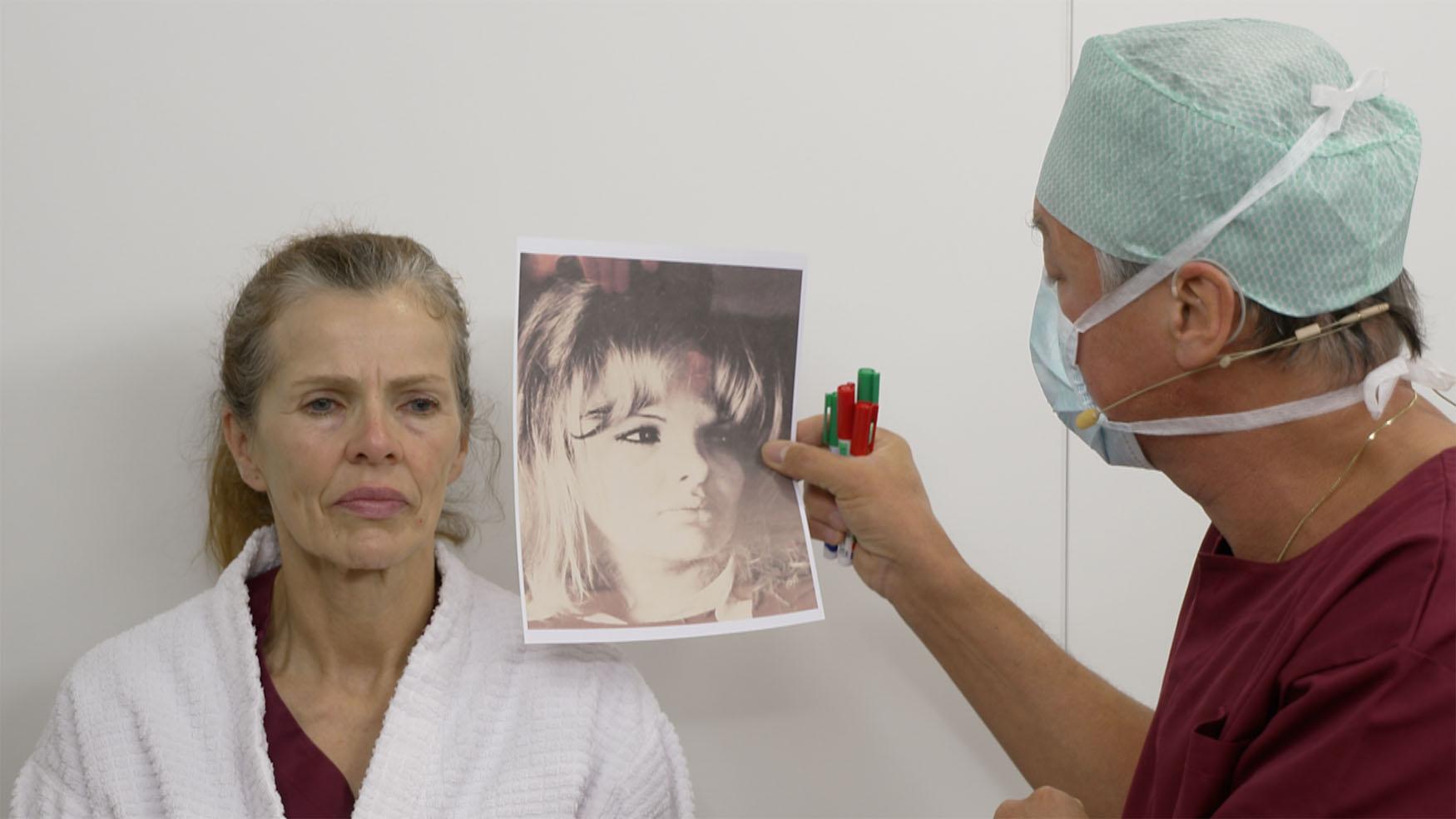
Systematic facial analysis will focus on the following:
Congenital malformations, asymmetry, scars, previous operations: Ranges from subtle deformity, like retruded chin or a small scar, to the more dramatic, like previous trauma or major illness such as Parry–Romberg syndrome. These malformations must be addressed.
Skin type and quality: Fitzpatrick skin type is recorded. Skin is being assessed for its quality and thickness, as well as photodamage, spots, depigmentation, skin lesions and rhytids.
Forehead: Evaluate forehead and glabellar rhytids, tonus and action of frontalis muscle and position of the eyebrows.
Periocular area: Evaluate the position of lateral brows and lateral hooding, presence of crow’s feet, dermatochalasis of upper eyelid skin, infrabrow hollowness and volume depletion ("A-frame" deformity), bulging of superior nasal fat pad, lower lid canthal tonus with scleral show or frank ectropion, lower lid skin redundancy and quality, bulging lower orbital fat compartments, presence and depth of orbitomalar groove (tear trough), and volume depletion of malar area.
Deflation of the orbitomalar area can be recognized in many facial rejuvenation patients and can be seen with or without bulging fat from descending fat compartments and with or without dermatochalasis. The best way to evaluate volume loss of the orbit is in comparison with an old photograph of the patient.
Anterior midface: Evaluate volume depletion of malar area and anterior cheek. This is best done in comparison to patients’ old photographs and in the oblique view of the patient (to assess the Ogee curve). Evaluate midcheek crease and the presence of festoons.
Perioral area: Evaluate the nasolabial fold characteristics, volume of upper and lower lip, vermilion and white roll, pouting and vertical length of upper lip, upper and lower lip wrinkles ("barcode” deformity), characteristics of marionette deformity.
The upper lip vermilion should be full and pouting, revealing 2–3 mm of the maxillary incisors. Mandibular incisors should not be seen. In the Caucasian face, in frontal view the lower lip is slightly fuller than the upper lip (golden proportion 1/1.618). In contrast, in the profile view, the upper lip should project a few millimeters anterior to the lower lip.
Lateral face : Evaluate presence of temporal wasting, lateral cheek hollowness and sagging, the position and volume of the buccal fat pad, and the definition of the jawline and presence of jowling.
Neck : Evaluate neck skin laxity and quality, horizontal neck rhytids, differentiate preplatysmal from retroplatysmal neck fat by platysma animation, evaluate submental skin laxity, skin laxity inferior to hyoid bone, presence of platysmal bands, and presence of ptotic submandibular glands and hypertrophic digastric muscles.
Décolletage : Evaluate skin quality, texture, wrinkles, and pigmentation.
Correctly recognizing patient's specific requests and goals is key to achieve the highest percentage of satisfied patients.
We select for our patients a combination of treatments from our tool box that, in our point of view, align with as many priorities mentioned by the patient, such as downtime, budget, etc., and will have the maximum impact on patient appearance. One of the most important factors in this idea is the concept of “synergy”, which means that the result of properly combined elements is greater than the mere sum of the individual elements. In other words, 1 + 1 = 3. For instance, the combination of a facelift and lipofilling is much more powerful than each of these procedures done separately. We rarely perform an isolated procedure (such as facelift alone), and it is very common in our practice to perform multiple rejuvenating procedures (sometimes more than 10) in a single operation.
There are numerous efficient facelift surgical techniques that yield good results. It seems logical that the more invasive and radical the rejuvenation procedure is, the more dramatic and long lasting the effect would be. This might be true up to a certain point, beyond which the risk of complication and unnatural results increases, as the procedure becomes more invasive. Beyond this point, there is a trade-off between a modest gain in effectiveness and the risk for complications, longer recovery, and downtime. The results of short scar facelift technique are comparable with those of the traditional full facelift incision techniques, in the nasolabial fold and jawline regions over time. This principle has eloquently been proved in the identical twin study where invasive and noninvasive techniques were performed on two sets of identical twins and results compared in the short and long term. Although some differences were noticed in the short term (less than 1 year), the conclusion in the long term was that both types of facelift (invasive and less invasive) yielded similar outcomes.
Ultimately, it is the delicate subjective balance between the final result and the morbidity of the procedure that will determine the level of patient happiness.
The MACS lift concept was first published in 2002. This procedure became well accepted worldwide, as many patients prefer a simpler route to rejuvenation, with shorter scar, faster recovery, and lowered downtime. The appeal of the MACS lift lies in the right balance between natural and stable results, and a simple and safe procedure with reduced downtime, minimal complications, and no facelift stigmata.
The senior authors now have more than 20 years of experience in performing this procedure, and we made no substantial changes in the basic surgical technique.
When the additional deformities are present, it is easy to add complementary procedures to the basic MACS lift in order to obtain a comprehensive and harmonic rejuvenation result. We routinely associate microfat grafting to the centrofacial area. In selected cases we add more extensive neck corrections via either an extra submental incision (subplatysmal fat resection, digastric corset, platysmaplasty) or via a retroauricular extension for a lateral subplatysmal displacement with or without submandibulary gland reduction.
The principle of the MACS lift is fourfold:
A limited pre-auricular and pre-sideburn skin incision
A limited subcutaneous dissection
No sub-SMAS dissection
Vertical vector suspension of the SMAS and platysma to the deep temporal muscle fascia by two strong purse-string sutures.
In contrast, a horizontal or oblique vector of correction does not rejuvenate the face. It tends to flatten the face, puts it under tension, and yields unnatural results.
With the MACS lift, the only vector applied on both the SMAS and the overlying skin is vertical. It can therefore be considered a pure vertical vector facelift technique. This results in an antigravitational repositioning of tissues in the upper neck and lateral face by suspension of the soft tissues, with limited skin undermining and no sub-SMAS delamination. The vertical vector of skin redraping and resection seals the underlying deep tissue suspension effect and avoids the retroauricular extension of the incision. Indeed in oblique vector skin redraping techniques the dog-ear created at the lobule necessitates a horizontal skin redraping and a retroauricular extension of the incision.
The MACS lift uses purse-string sutures to suspend mobile facial and neck soft tissues to the non-mobile deep temporal fascia. The proximity of the suture loops close to the lax tissues in the mobile area of the face produces a very effective transmission of the traction forces of the purse-string suture. Another advantage of the purse-string technique is that it creates micro imbrications of the SMAS, that coalesce during the healing phase stabilize the lifting effect and facilitates volume restoration of the cheek.
In comparison with a classic facelift, the MACS lift patients experience a shorter recovery time and a lower morbidity rate, with a final scar that is significantly shorter.
The MACS lift provides a powerful correction of the jowls and restoration of a crisp jawline, volume restoration of the midcheek area, improvement of the nasolabial folds, correction of the marionette grooves, correction of submental and upper neck laxity above the hyoid bone and correction of a blunted cervicomental angle.
The operation takes about 1.5 to 2 hours to perform and can be done under local anesthesia.
Incision marking ( Fig. 9.4.3 ) starts at the lower limit of the lobule, going up in the pre-auricular crease. At the level of the incisura intertragica, the marking makes a 90° turn backward to preserve this anatomic landmark. The marking then follows the posterior edge of the tragus, ascending toward the helical root. At the superior limit of the ear, the marking follows the small hairless recess between the sideburn and the auricle and then turns downward to follow the inferior implantation of the sideburn. In males, the marking descends approximately 1.5 cm before turning anteriorly to cross the sideburn. The marking runs further forward in a zigzag pattern, 2 mm within the lower and anterior implantation of the sideburn. The purpose of the zigzag pattern is to increase the length of the temporal incision for better congruence with the length of the cheek flap, thereby reducing dog-ear formation. The incision extends to the level of the lateral canthus and no higher than the level of the tail of the eyebrow.

Skin dissection will take place two fingerbreadths below the mandibular angle and corresponds with the cranial border of the platysma. The anterior point of the dissection is a point halfway between the tragus and the oral commissure. These two dots are then connected in an oval shape that continues towards the sideburn.
We use an infiltration solution that contains lidocaine, ropivacaine, epinephrine (adrenaline), corticosteroids and tranexamic acid ( Box 9.4.1 ). First the submental area is infiltrated, followed by the cheek infiltration ( Fig. 9.4.4 ).
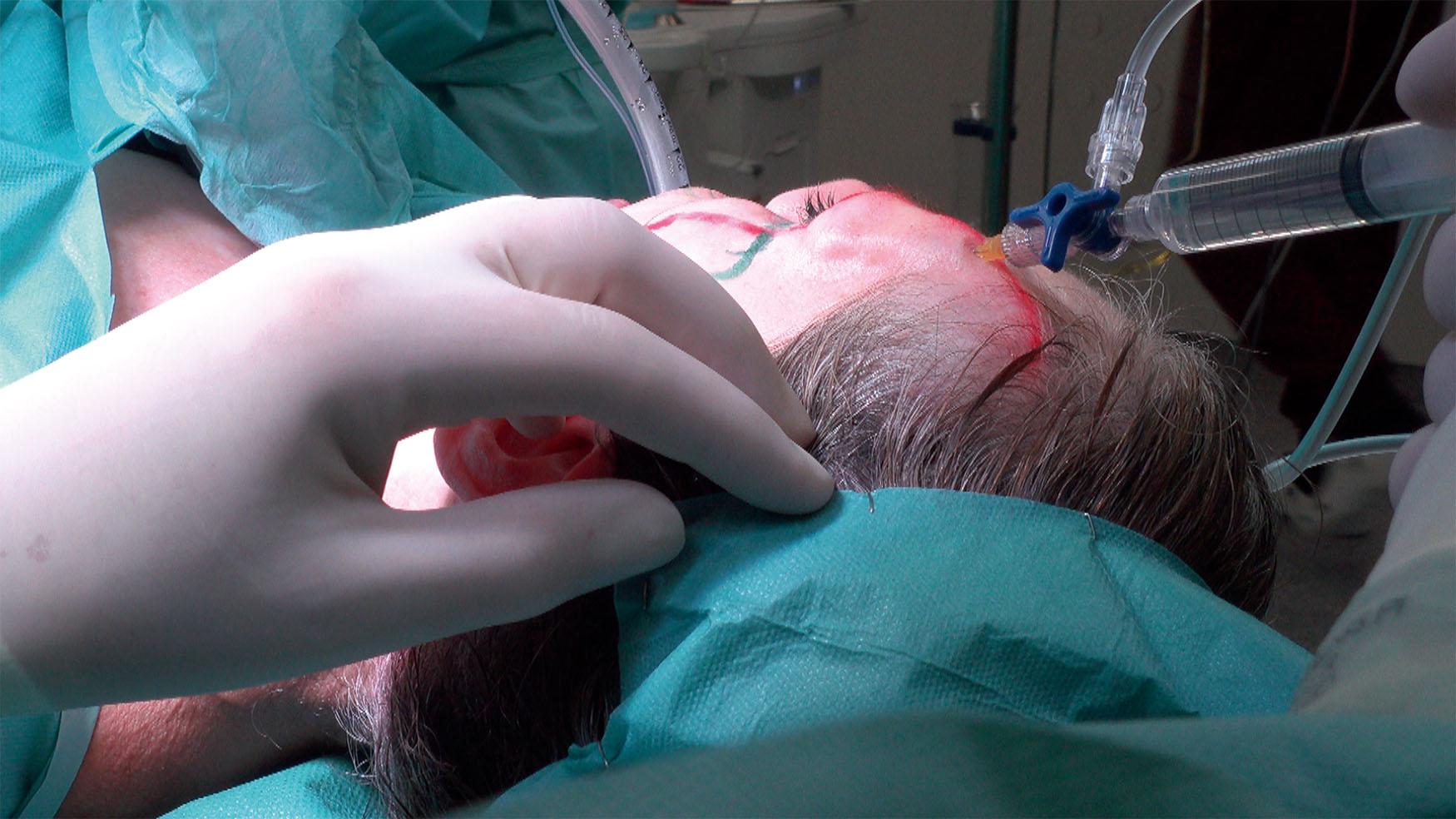
Along the sideburn, the incision follows a zigzag pattern and the knife is inclined to an almost tangential angle with the skin in order to cut hair shafts perpendicularly. This maneuver will help conceal the scar as it allows hair to grow through it, and become virtually invisible ( Fig. 9.4.5 ). The skin dissection starts with a knife for the first centimeter to determine the dissection level The rest of the dissection is done blindly with strong Gorney-type facelift scissors in a subcutaneous plane. We point the edges of the scissors toward the skin to have visual and tactile control over the thickness of the flap. Most of the dissection is done by spreading maneuvers ( Figs. 9.4.6 & 9.4.7 ). The flap is created with sufficient thickness, usually 3-4 mm, to mask small irregularities of the underlying tissue.
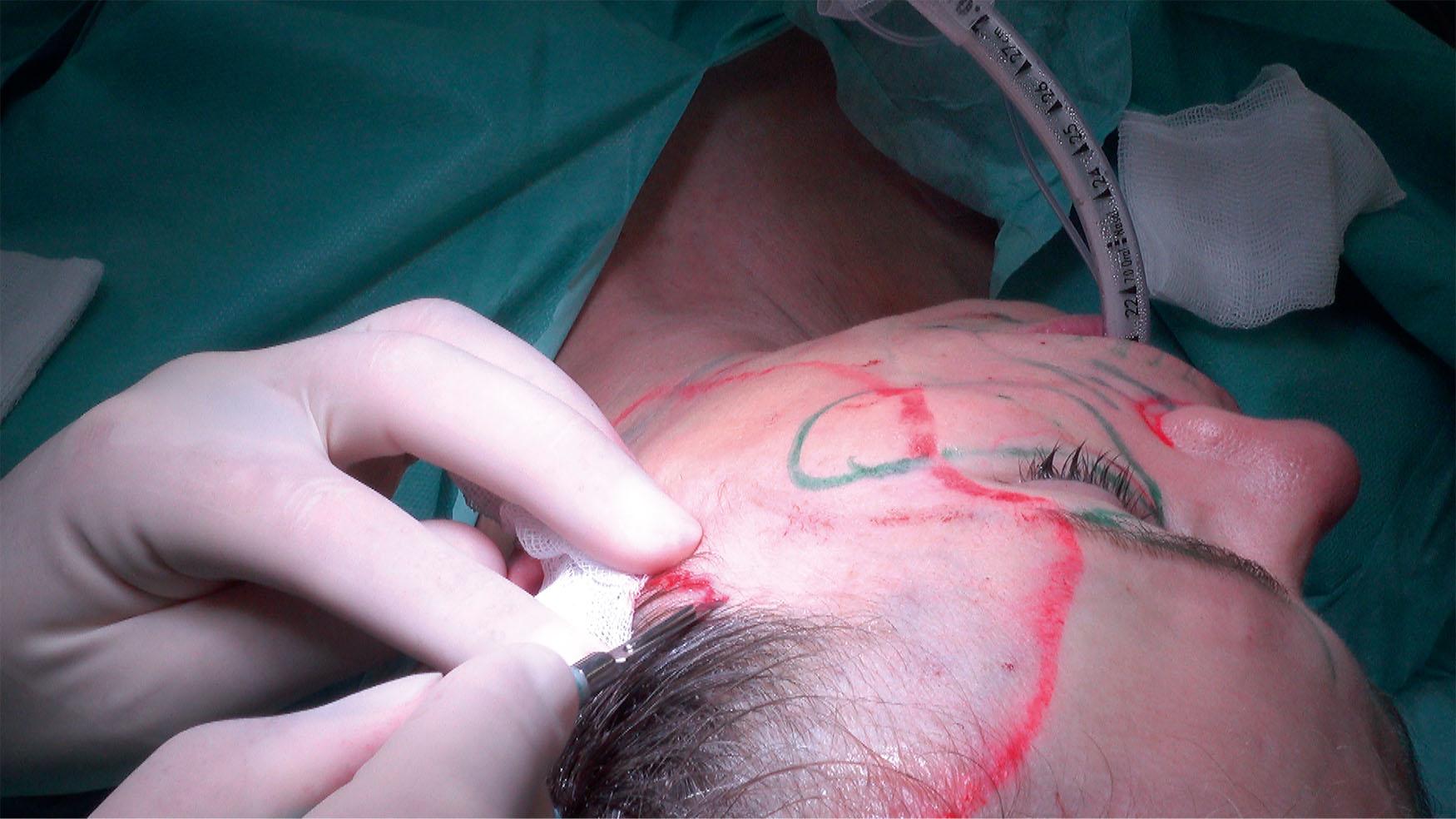
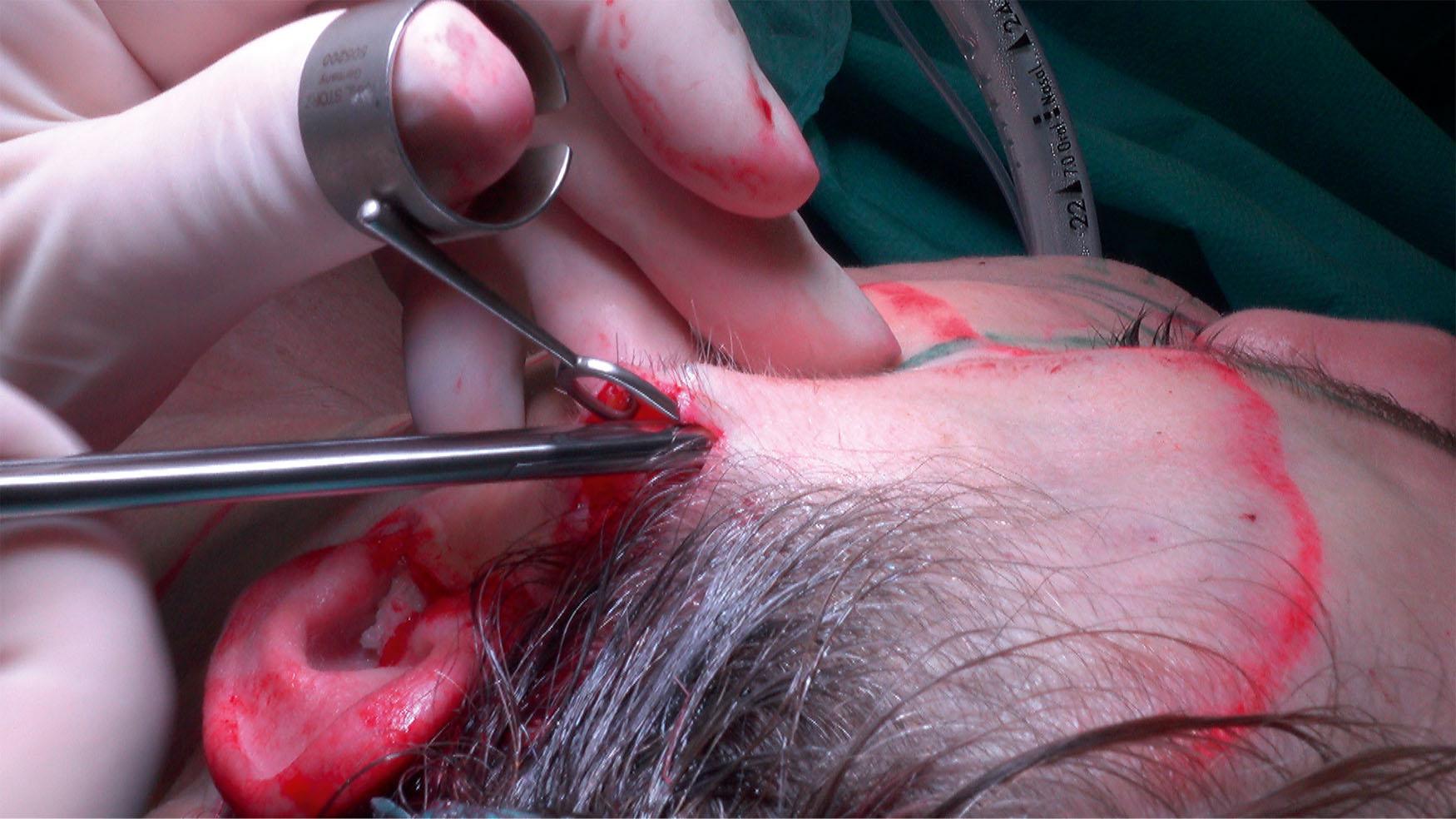
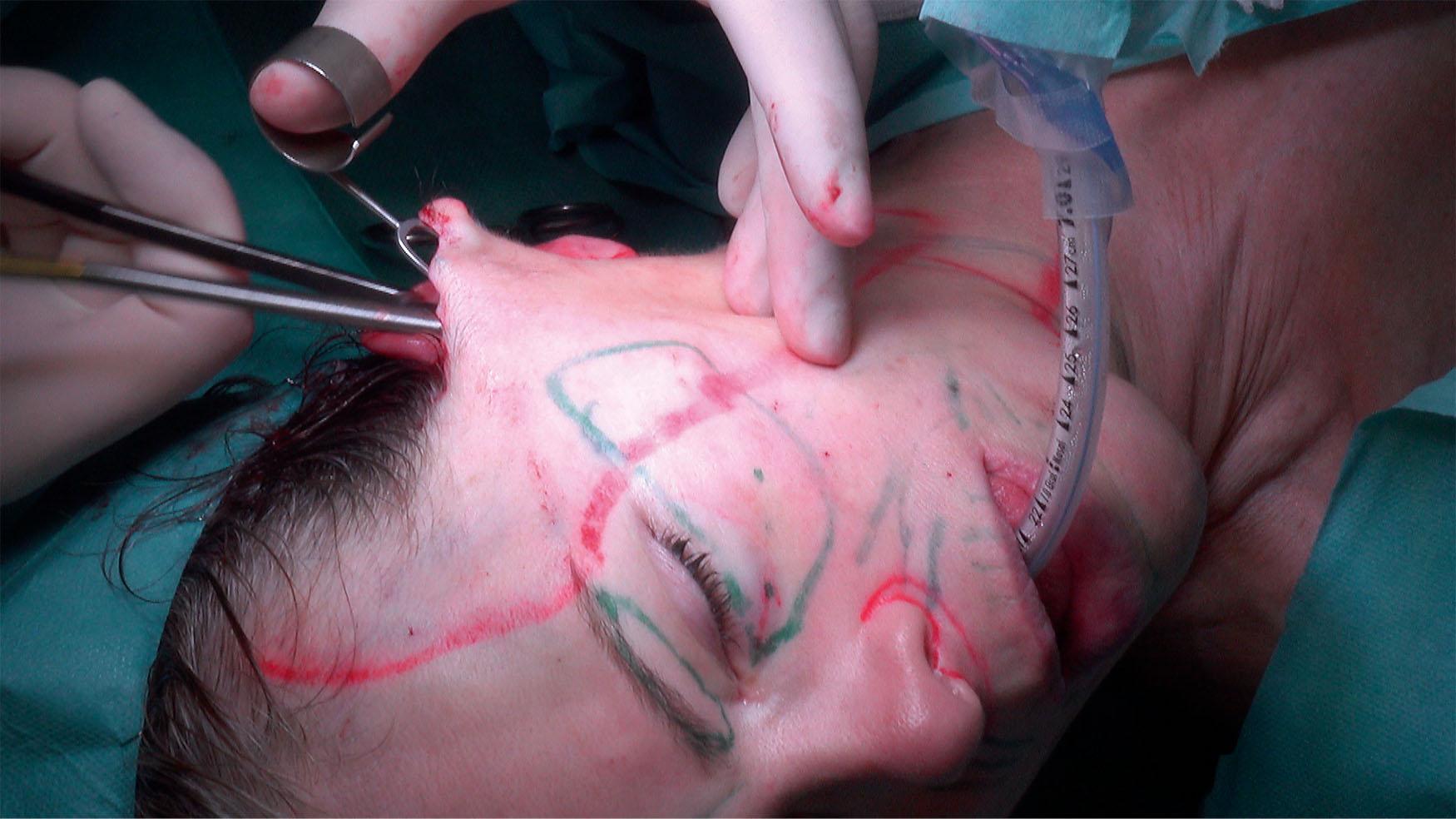
The first purse-string suture – the vertical loop – is fixed to the deep temporalis fascia (DTF) at a point 1 cm above the zygomatic arch and 1 cm in front of the root of helix ( Fig. 9.4.8 ). This area of the DTF is exposed with sharp scissors and spreading motions after hydrodissection with local anesthetic. The DTF is identified as a distinct white shiny layer ( Fig. 9.4.9 ). A 0 polydioxanone (PDS*II; Ethicon, Somerville, NJ) suture with a 23 mm C3 needle is used for suspending the sagged facial and neck soft tissues. The first needle bite is done in the window where the DTF was visualized and goes down to the temporal bone. The needle is oriented toward the tragus to avoid danger zones and damage to any branch of the facial nerve. Firm bites of 1–1.5-cm long and 0.5-cm deep are taken in the SMAS tissue and platysma ( Fig. 9.4.10 ). Every bite of the needle must take a substantial part of SMAS tissue to avoid pulling through. The suture continues down, toward the region of the mandibular angle until the lower limit of the undermining. A minimum of two to three strong bites should be taken in the platysma muscle, which is usually visible at the area of the mandibular angle. The suturing is then turned upward and continued toward the starting point, creating a 0.5- to 1-cm-wide U-shaped purse-string. The loop is tied under maximal tension ( Fig. 9.4.11 ). Any skin dimples caused by this suture can be undermined with scissors.
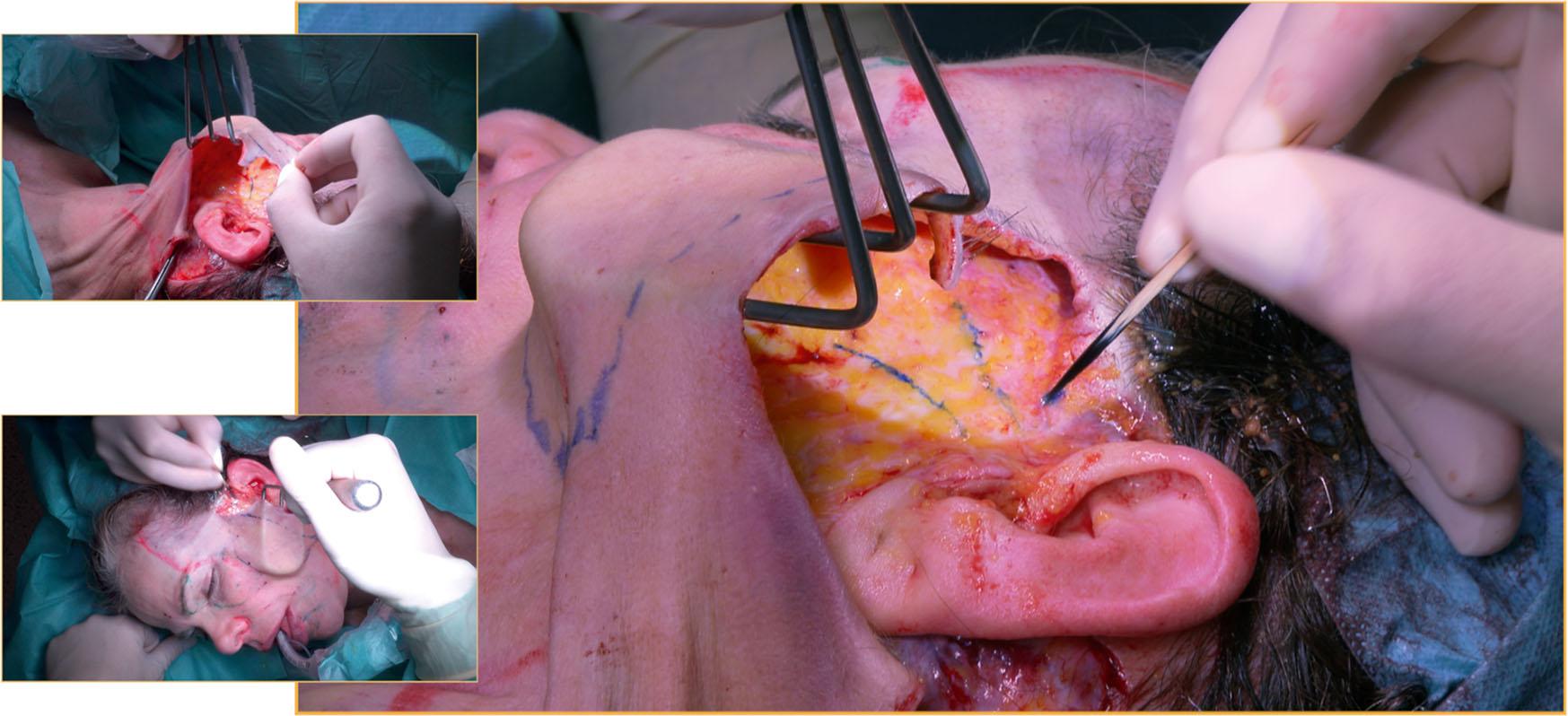
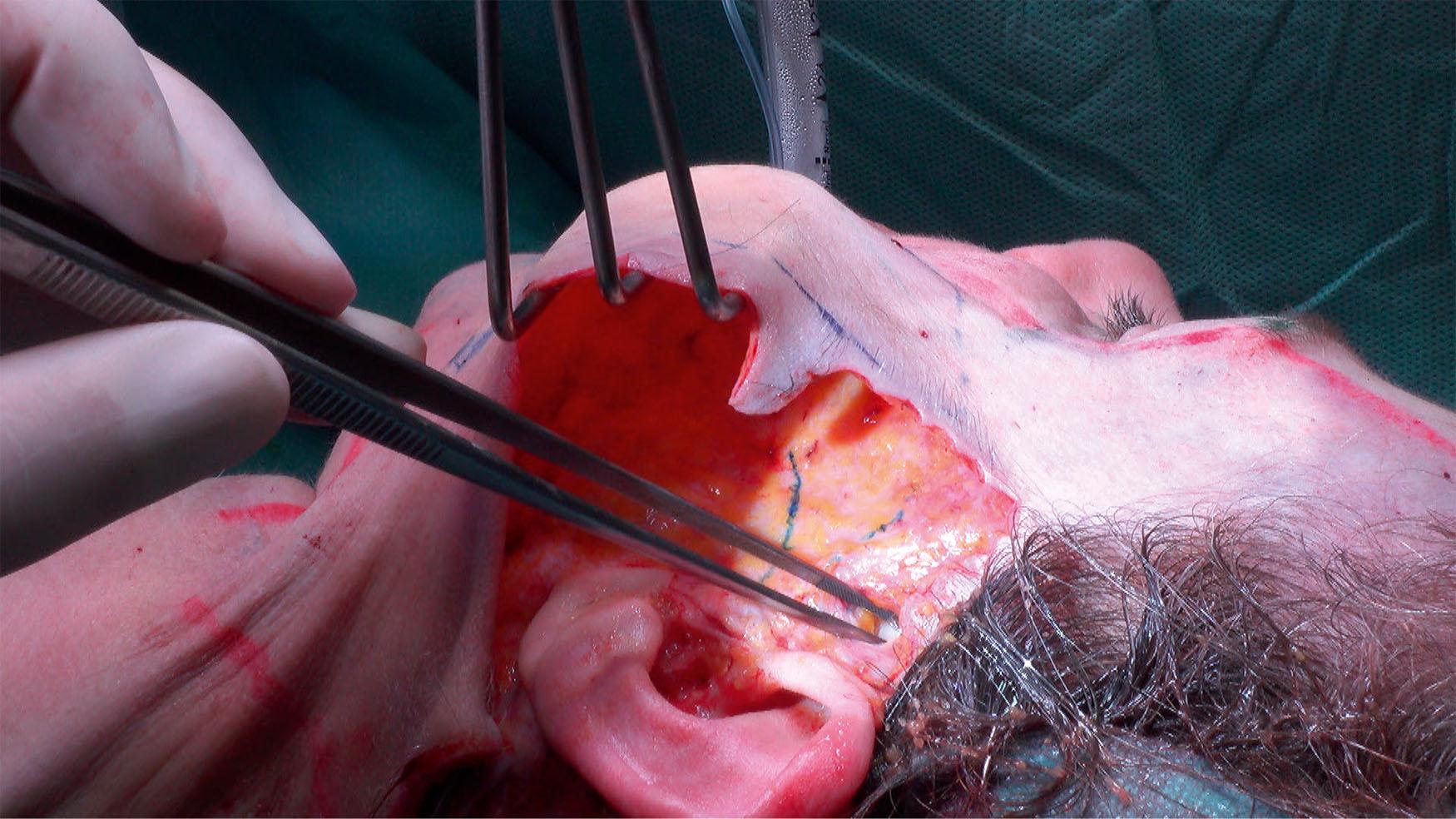
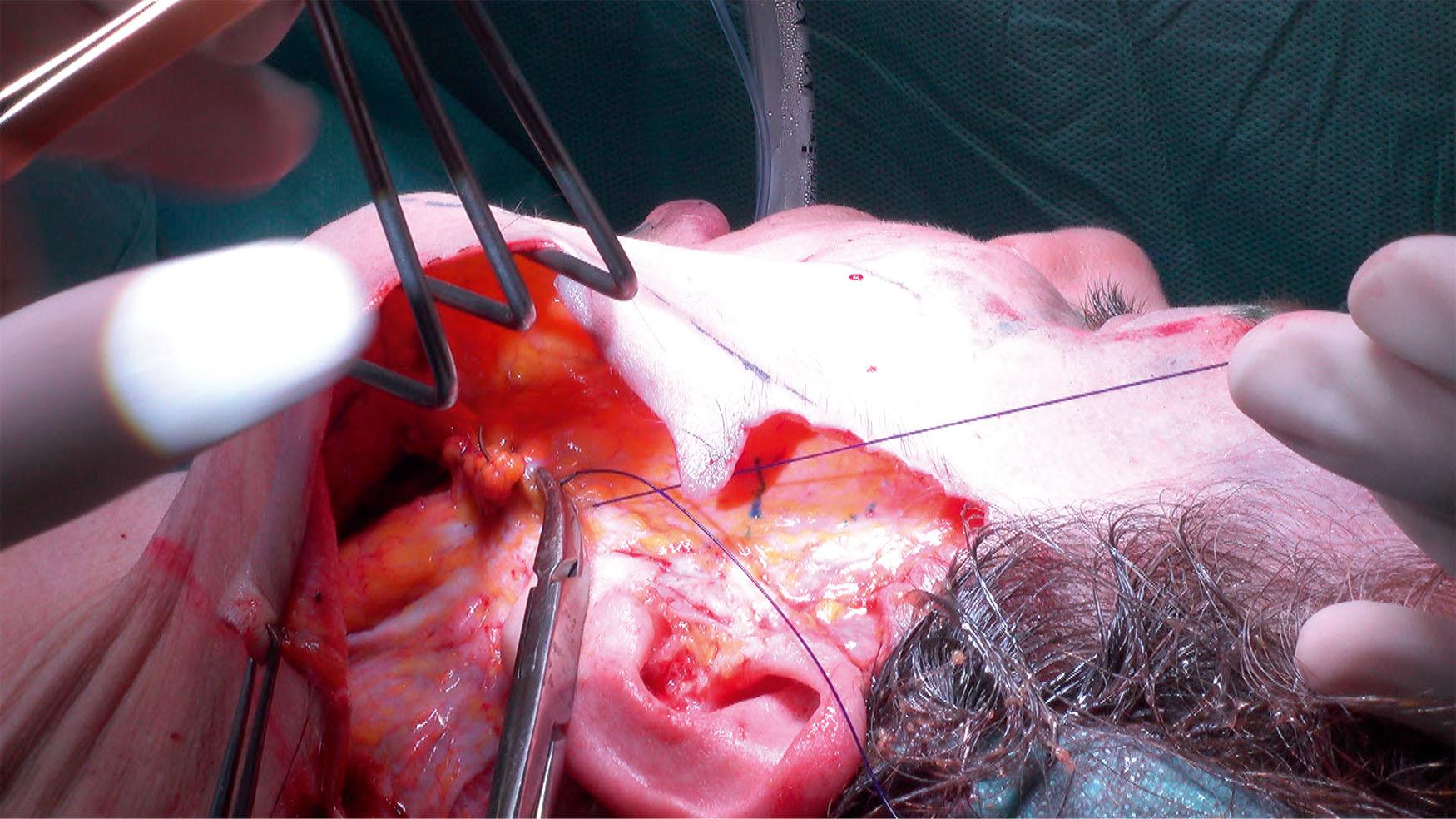
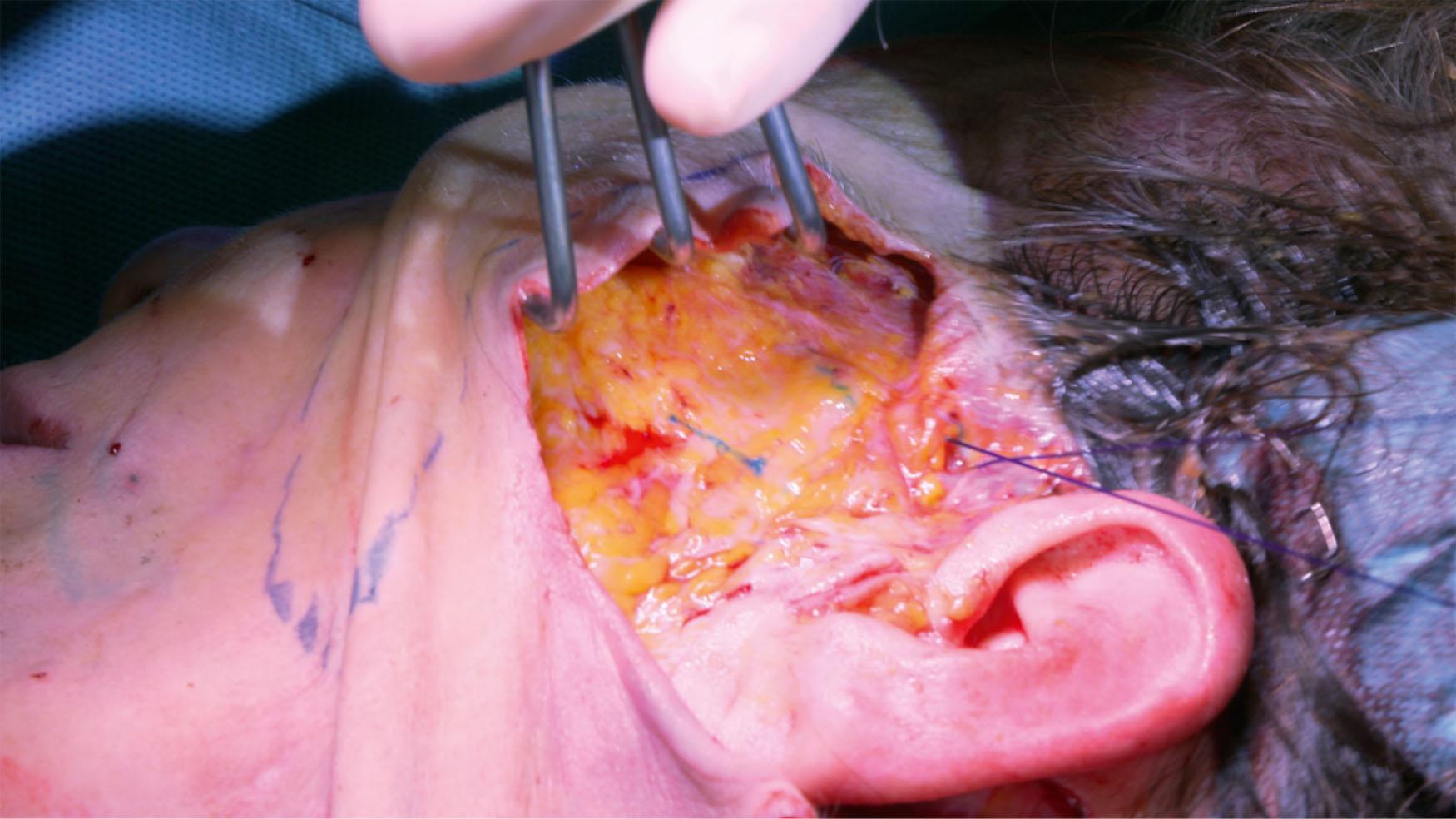
The second purse-string suture – the oblique loop – starts at the same location on the DTF as the first suture ( Fig. 9.4.12 ). This suture forms a wider O-shaped loop, directed toward the jowls at an angle of 30° with the vertical loop. The descending limb of this loop is parallel to the first suture and turns anteriorly toward the jowl along the mandibular border. Next, it follows the anterior borders of the skin flap and is then directed back toward the anchor point, where it is tied under strong tension. Some skin dimples may have to be freed at the borders of the undermined area using scissors ( Fig. 9.4.13 ).
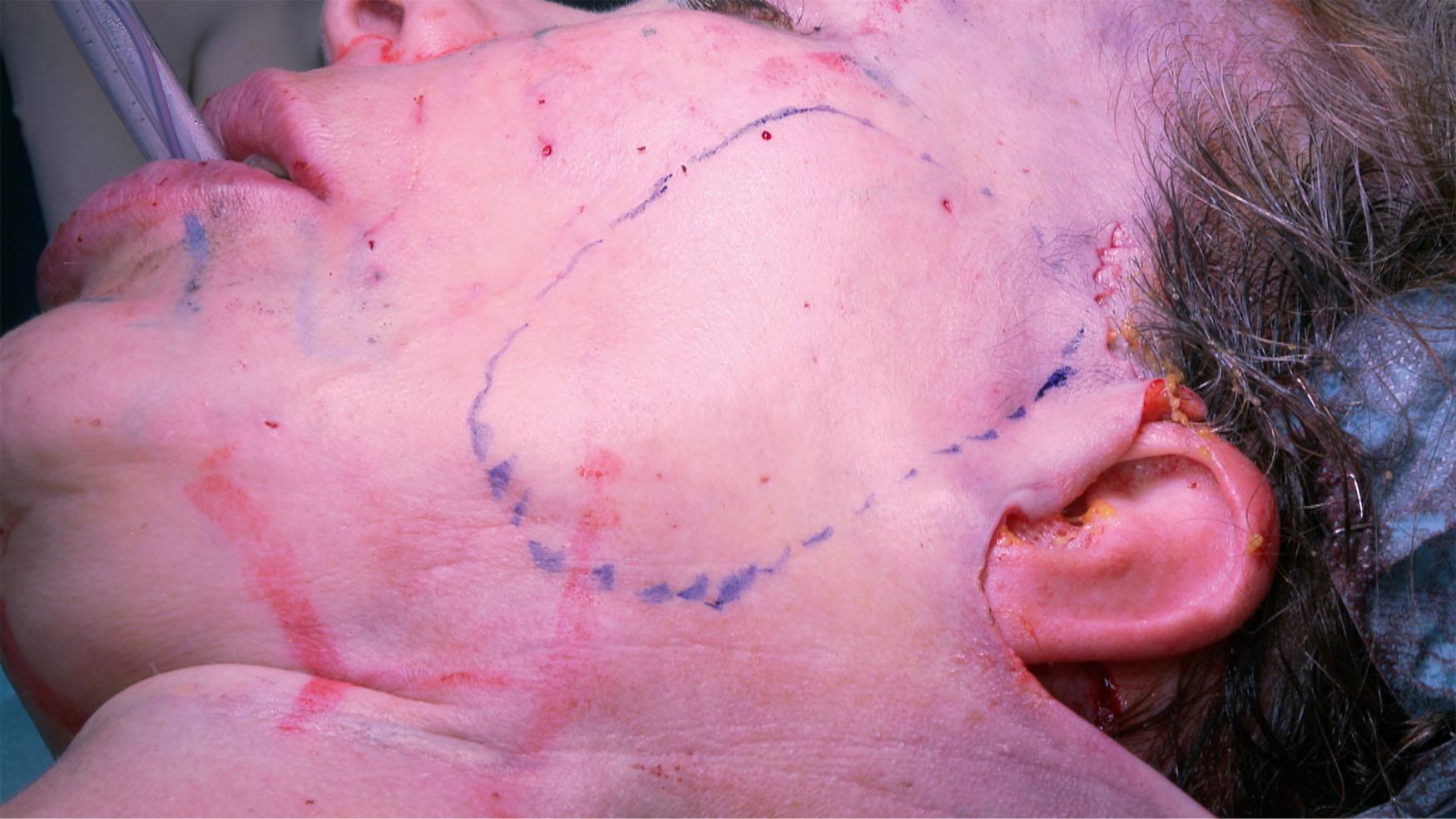
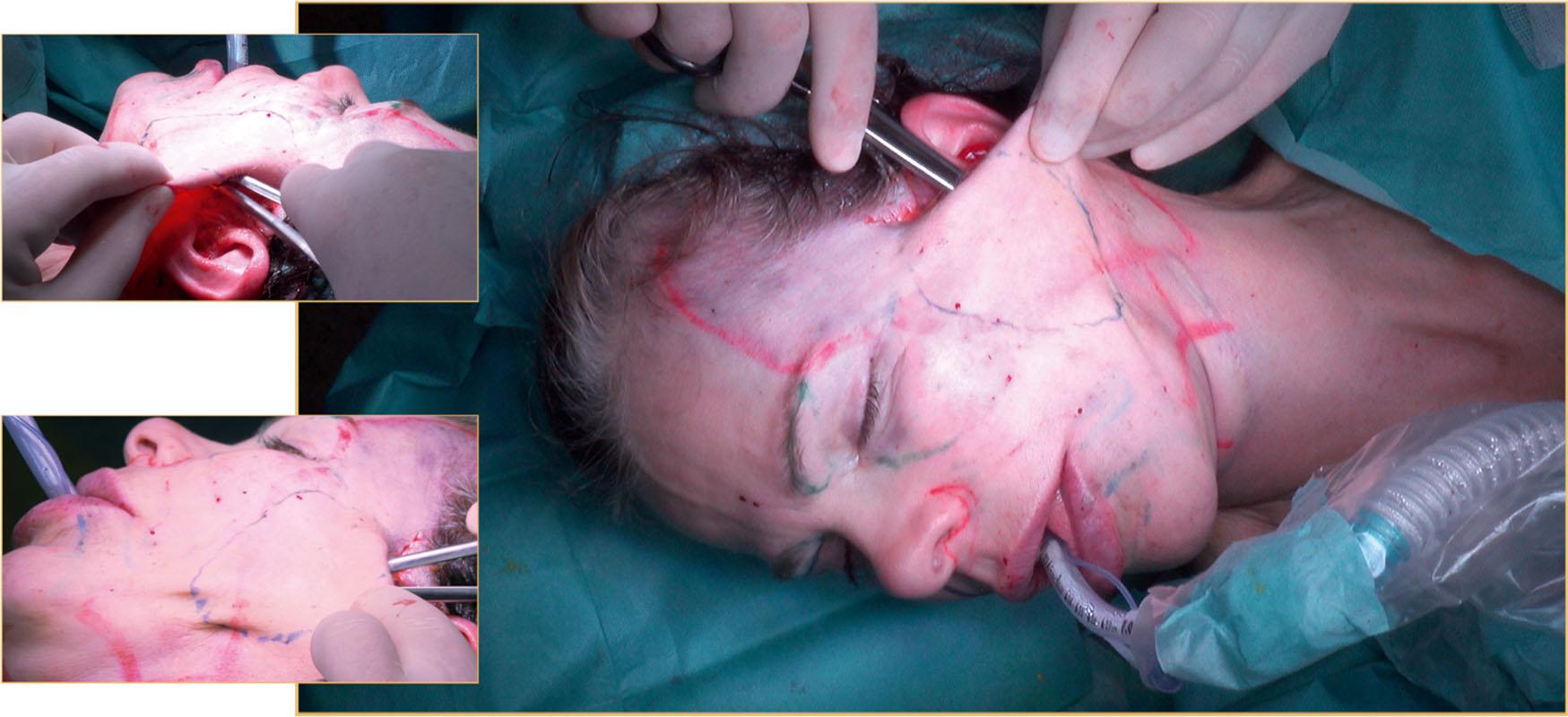
The window in the SMAS is closed with 4-0 Vicryl (Ethicon) to prevent knot palpability. Sometimes a bulging of SMAS tissue is visible within this loop after tying. This bulging can be treated by upward suturing of the cranial part of the bulge with a running 4-0 Vicryl suture ( Fig. 9.4.14 ) and trimming of the caudal part of the bulge ( Fig. 9.4.15 ). This technique enhances the malar volume and improves the triangularization of the face. An alternative option is to imbricate the bulged tissue with 4-0 Vicryl figure-of-eight sutures when extra malar volume is not desired.
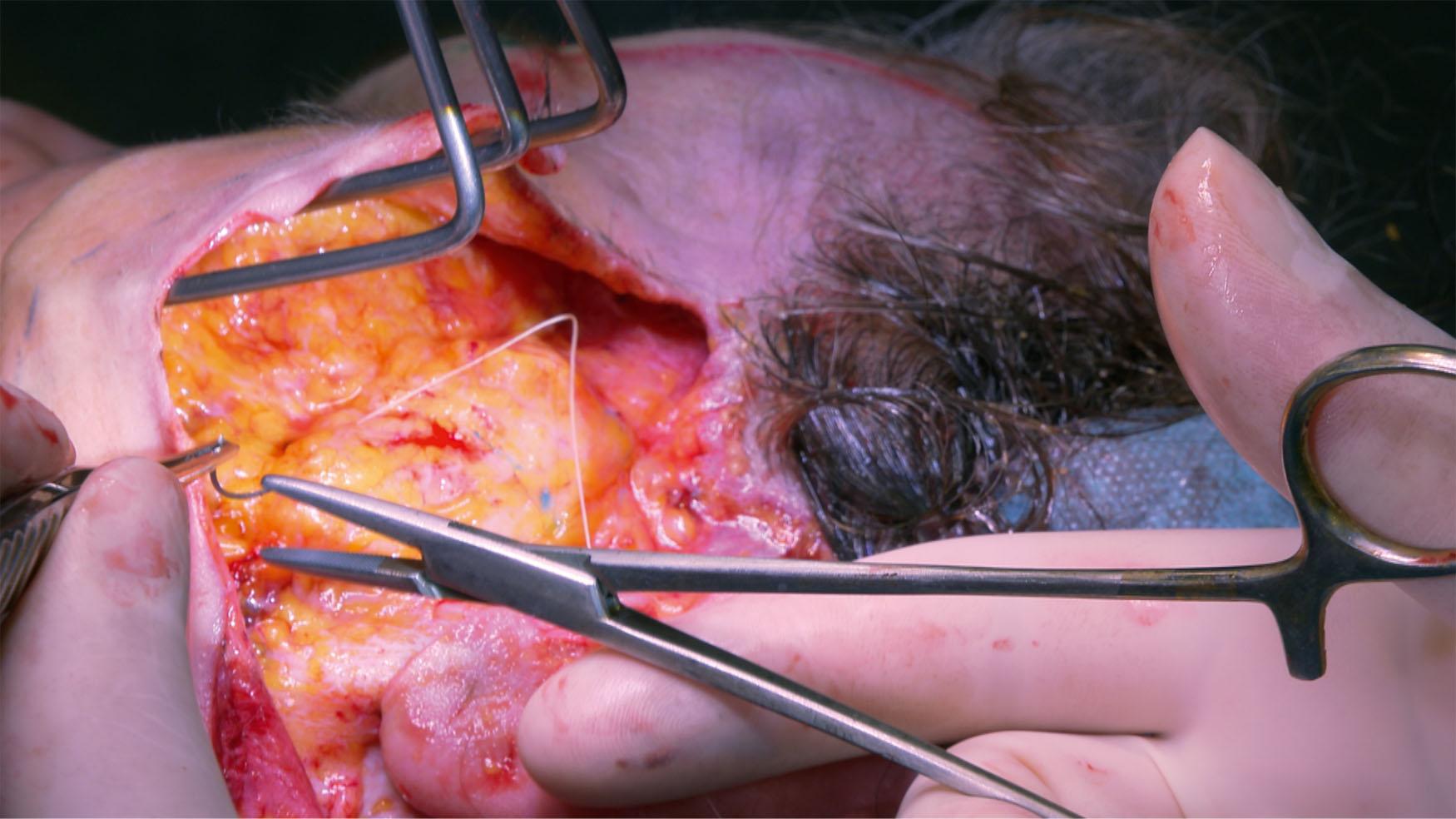
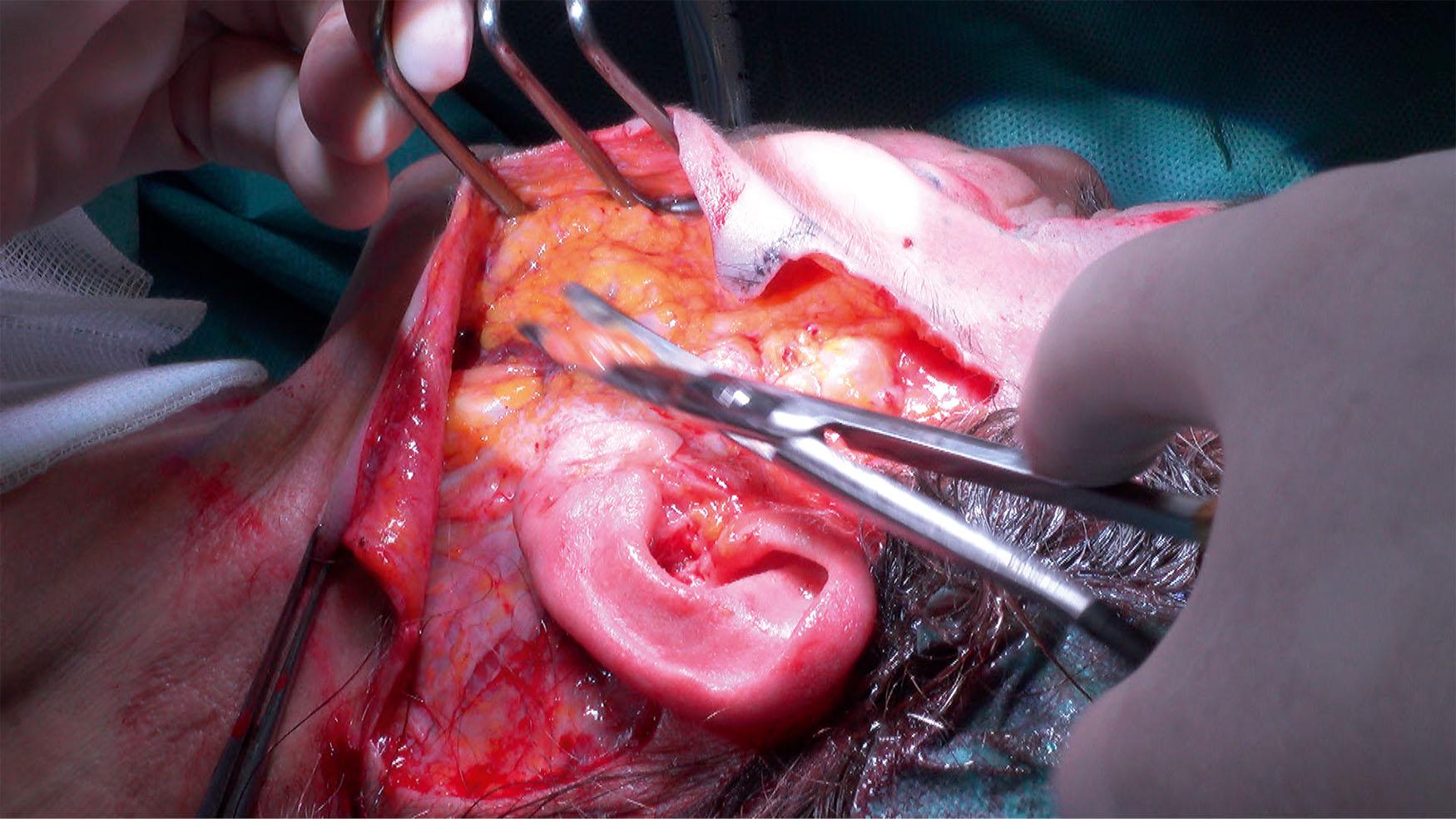
After vertical redraping of the skin without tension, the amount of skin to be resected in the temporal area is assessed with a Pitangui-d’Assumpcao forceps ( Fig. 9.4.16 ). In the sideburn, skin resection is performed in a curvilinear fashion ( Fig. 9.4.17 ). The edge will be sutured to the zigzag border of the temporal hairline incision, as the zigzag incision will then stretch when coopting with the linear cheek flap, compensating for the discrepancy in length of both borders and reducing possible dog-ears. Closure with interrupted 4-0 PDS buried sutures is started superiorly and downward, to avoid dog-ears ( Fig. 9.4.18 ). Pre-auricular skin excision is then performed ( Fig. 9.4.19 ). This excision is minimal due to the vertical redraping and the absence of lateral traction. The earlobe is set back without any tension by excising a small triangle of skin ( Fig. 9.4.20 ). Skin suturing is performed with running 5-0 nylon sutures in the temporal and sideburn part of the incision, running 6-0 nylon suture for the vertical part of the incision.
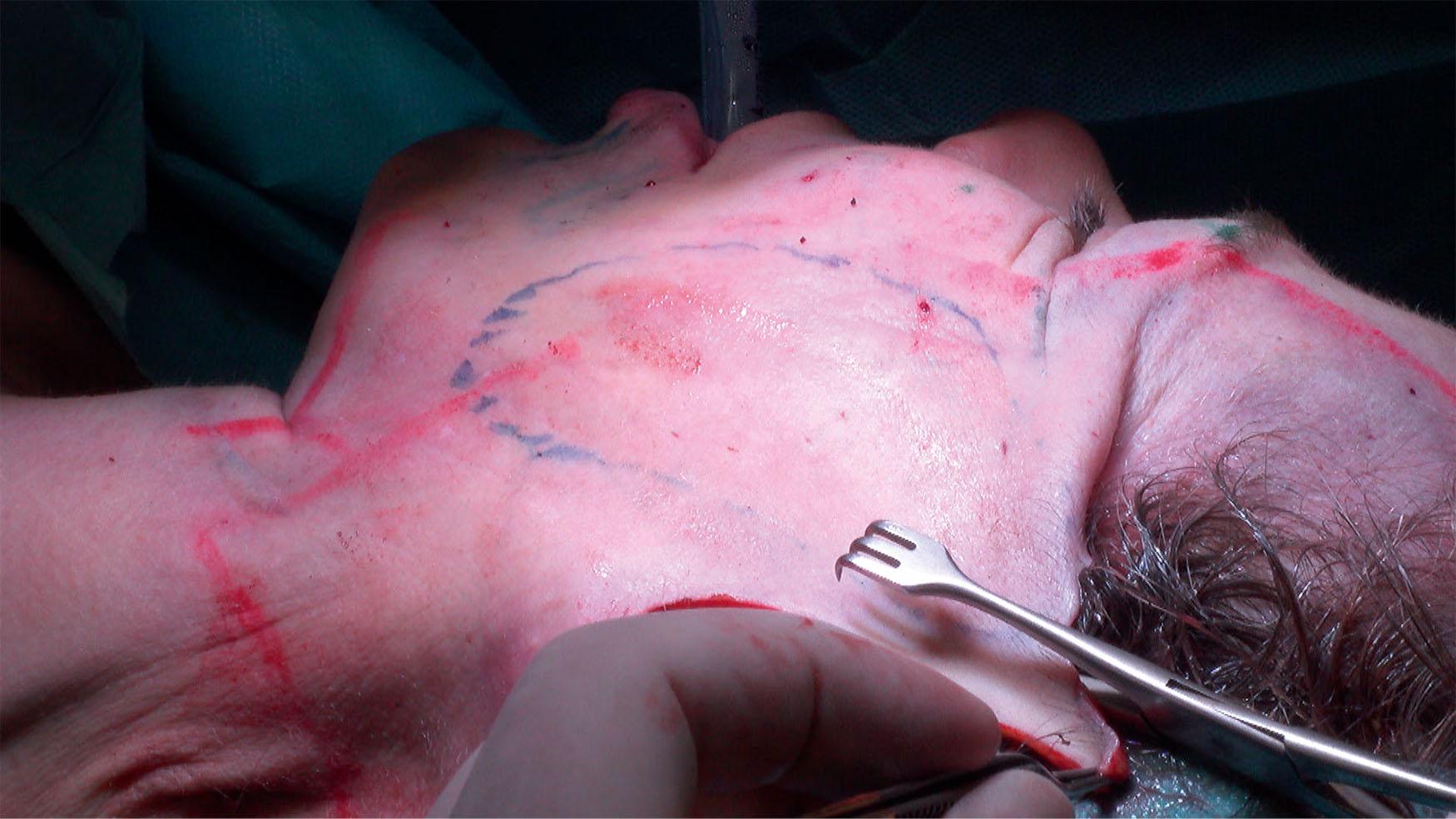
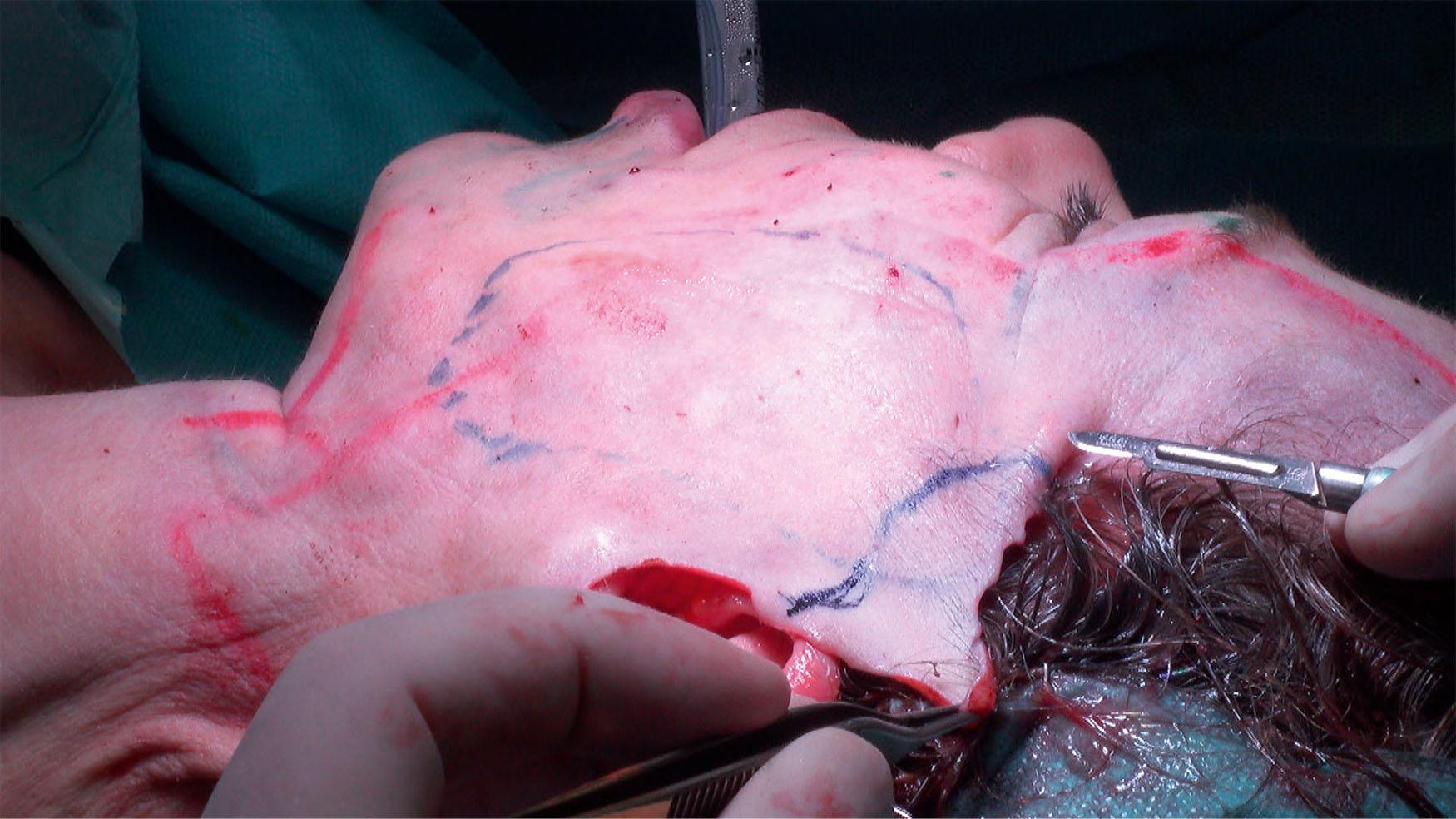
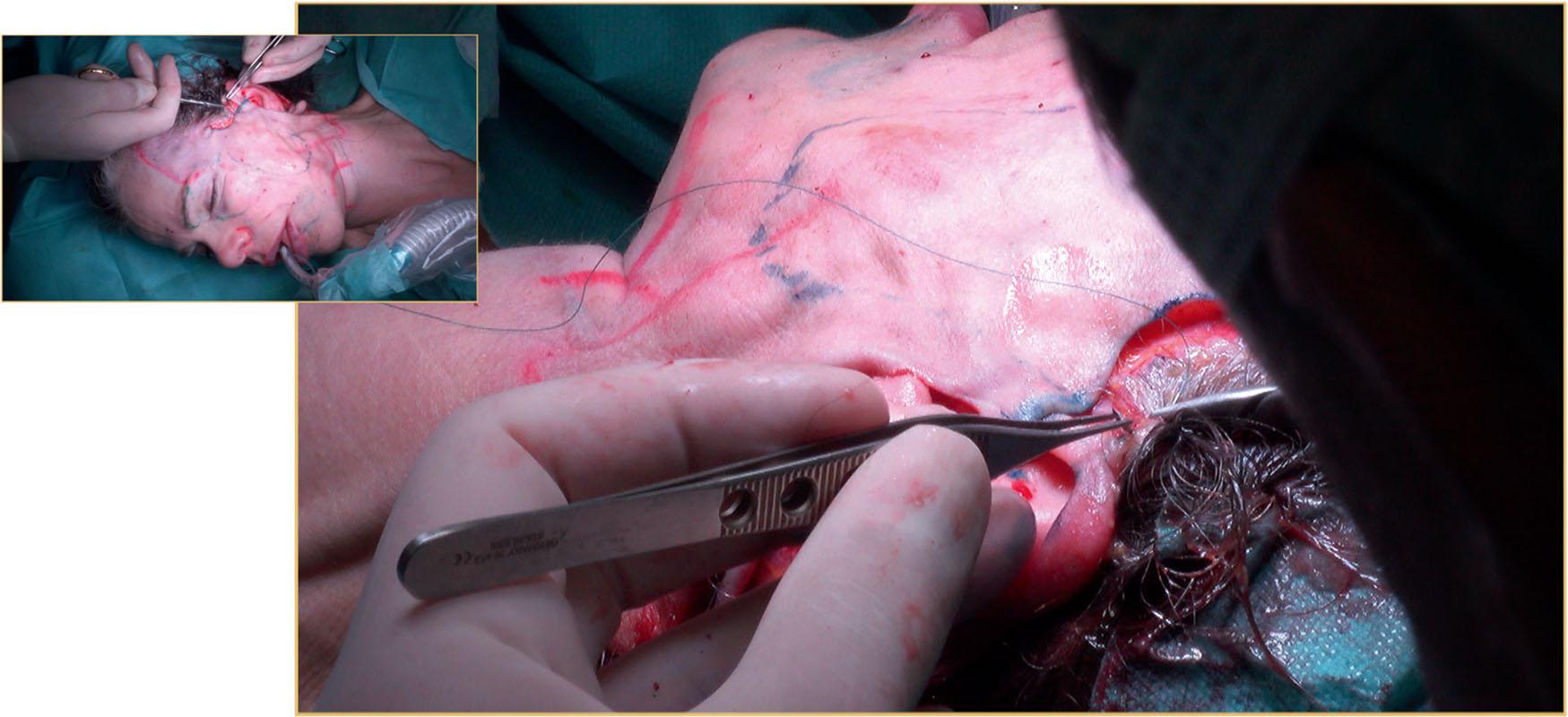
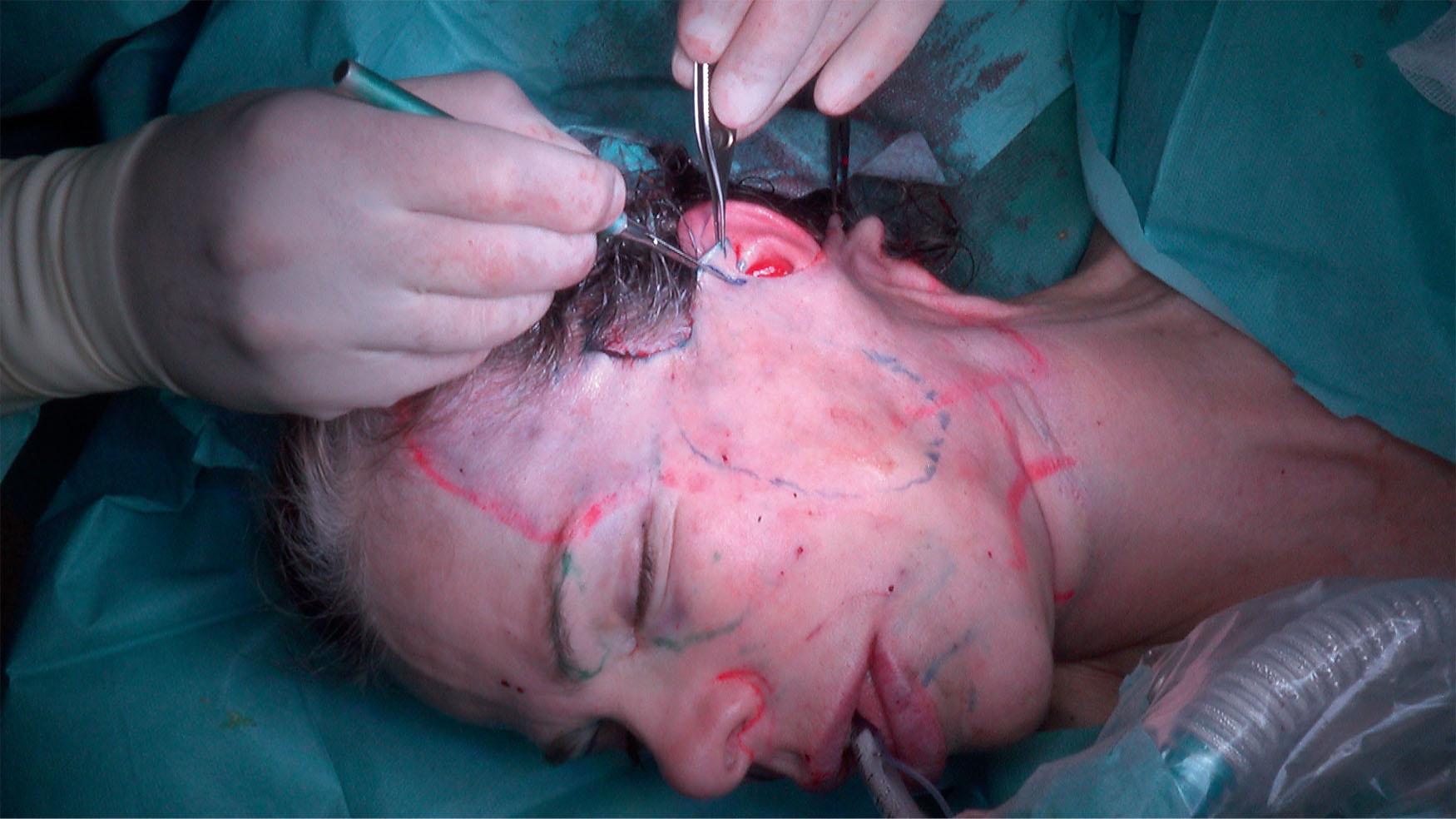
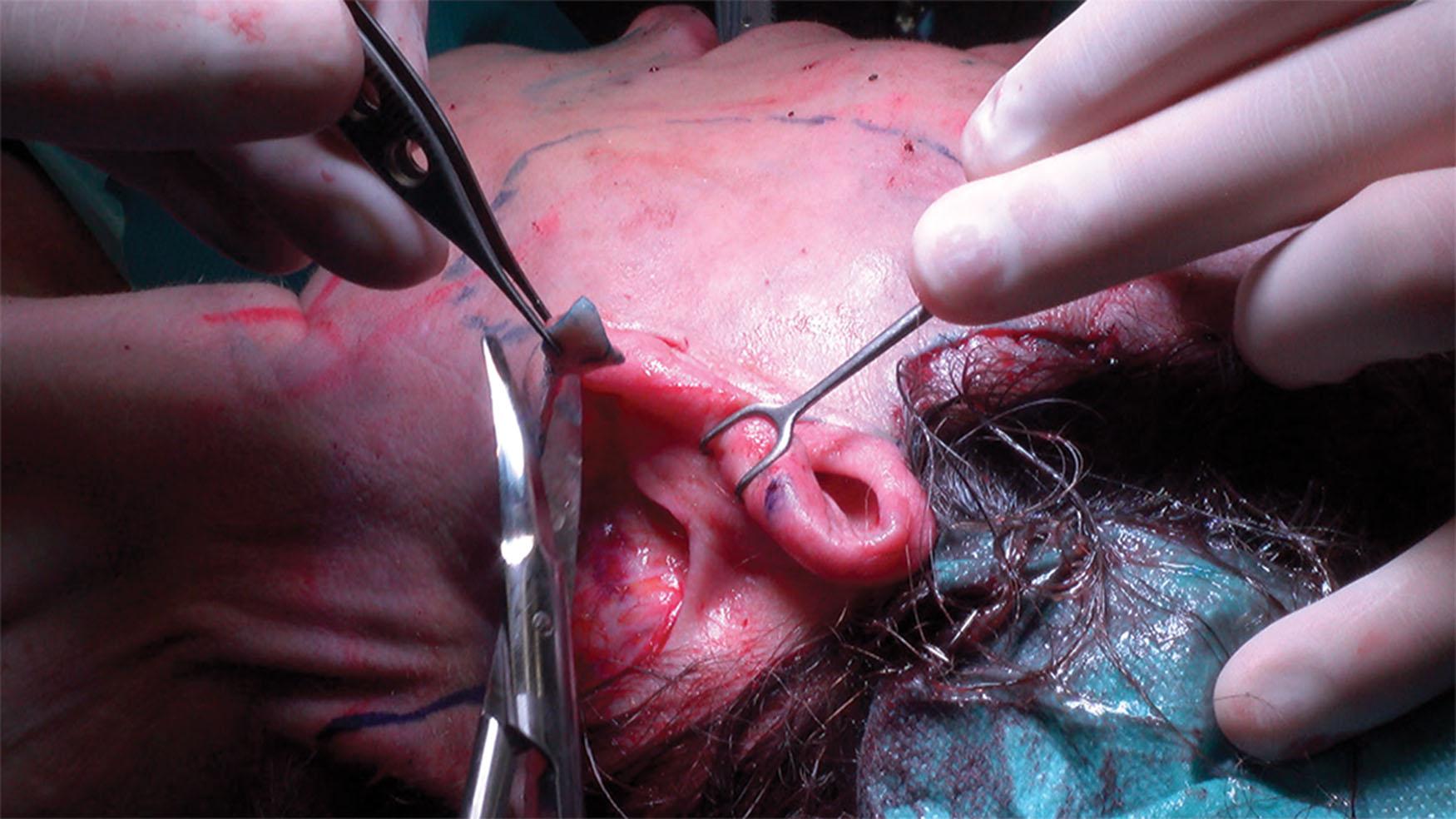
Originally described by Andre Auersvald, the hemostatic net is a technique that uses quilting 5-0 nylon sutures, connecting the undermined skin flap with underlying deep tissue. This maneuver eliminates the potential space between the two tissue layers, and prevents hematoma. Moreover, this technique allows for redraping and fixation of the skin beyond what the surgical lifting has achieved, thus eliminating the chances of bothersome folds and areas of lax skin ( Fig. 9.4.21 ). The hemostatic net is removed typically after 48 hours to prevent stitch marks.
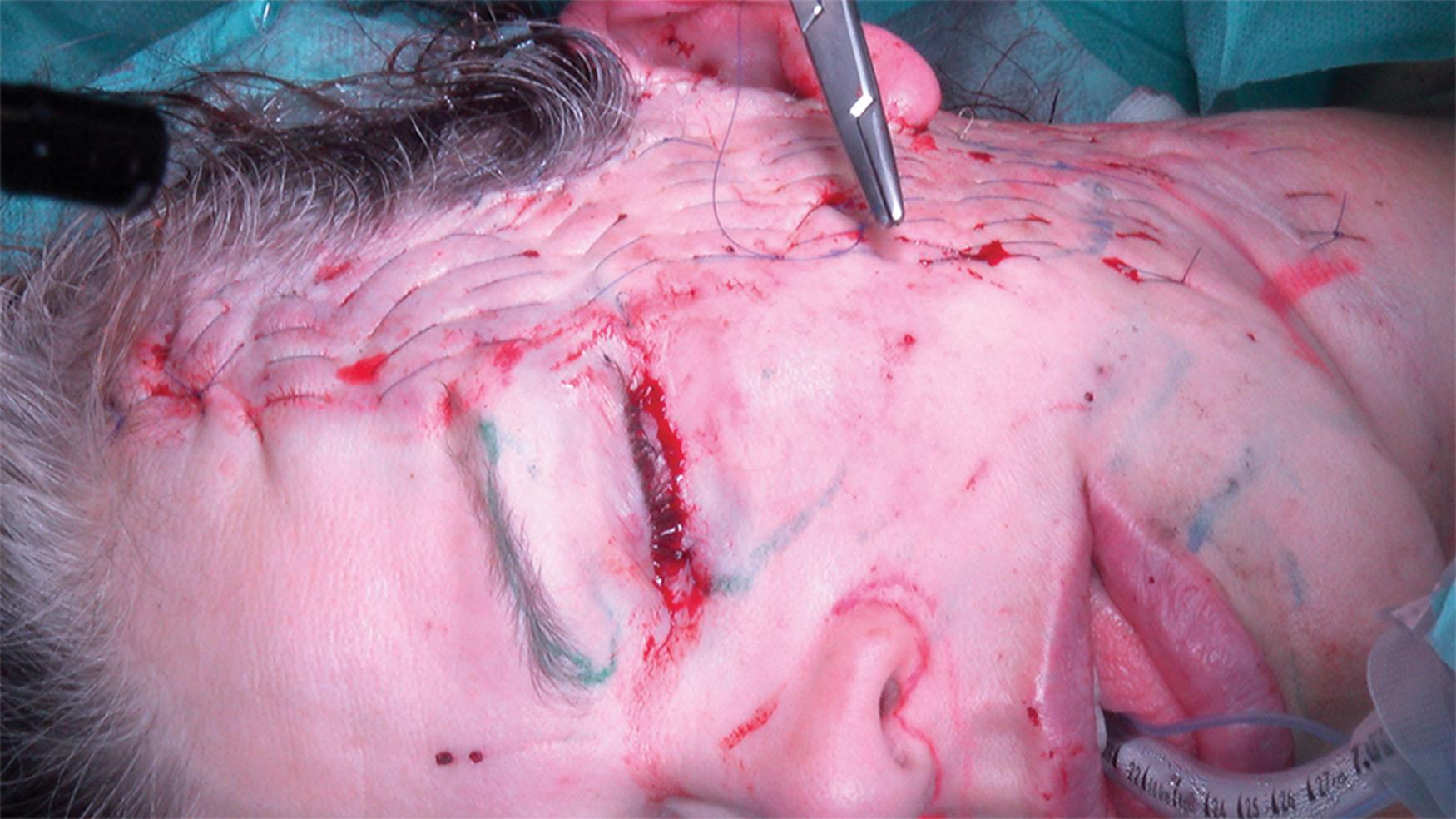
This technique has obviated our need for suction drains and any dressing.
When concerning the neck in facial rejuvenation patients, two of the most important questions are whether to perform a supplementary neck surgery, and whether to open the neck or not. To answer those questions, we take various factors into consideration.
When evaluating the patients, we evaluate the presence of retro- or pre-platysmal neck fat, ptosis and/or hypertrophy of the digastric muscles and submandibulary glands, the presence of platysmal bands and neck skin laxity, and neck skin quality.
For patients between the ages of 45 and 55 with pre-platysmal fat, no ptosis or hypertrophy of the digastric muscles or submandibulary glands, and no prominent platysmal bands or skin laxity inferior to the hyoid bone, it is mostly unnecessary to perform supplementary neck surgery on top of the MACS lift. For those cases we perform a liposculpture to remove the subcutaneous fat in the submental area before performing a simple MACS lift to restore a pleasing cervicomental angle. In this group of patients, during the initial consultation, when simulating the MACS lift effect with three fingers on each pre-auricular area, simulating a vertical lifting of the facial tissues, a sufficient improvement of submental laxity is most often observed.
For liposuction of the neck and sometimes also the inferior part of the jowls, we ask the patient to flex the neck and produce a double chin. The area of fat excess is then marked between the visible skin folds, usually from earlobe to earlobe, and vertically from the submental crease to the thyroid cartilage. Heavy jowls are also marked for liposuction as needed.
We most often use a 3-mm spatula cannula with one opening, directed away from the skin to avoid dermal damage. A 3-mm submental incision is used, and sometimes an additional access from the prelobular incision is made to optimally address and criss-cross the area for preplatysmal liposuction. The uniformity of lipoaspiration is assessed by a thumb/index pinch test. Usually a layer of 3-4 mm is preserved for a soft contour.
The indications for an anterior cervicoplasty through a submental incision are the presence of large amounts of subplatysmal fat and/or a ptosis or hypertrophy of the digastric muscles and submandibulary glands. After direct excision of the subplatysmal fat, and partial resection of hypertrophic digastric muscles and/or submandibular gland, a digastric corset is performed, with deep sutures than include the mylohyoid muscle and reinforced with platysmorrhaphy.
In case of prominent platysmal bands, especially in thin-skinned patients and/or a neck laxity below the hyoid bone which needs a horizontal redraping, we adopted the LSD neck lift (lateral subplatysmal displacement) technique. The neck skin is undermined from a posterior auricular approach incision, which in combination with a MACS lift results in a full facelift incision. Also the posterior incision is precapillary for preservation of the natural hairline. The skin dissection is limited, and carried only to a vertical line, marked 4 cm lateral to the medial platysmal bands ( Fig. 9.4.22 ).
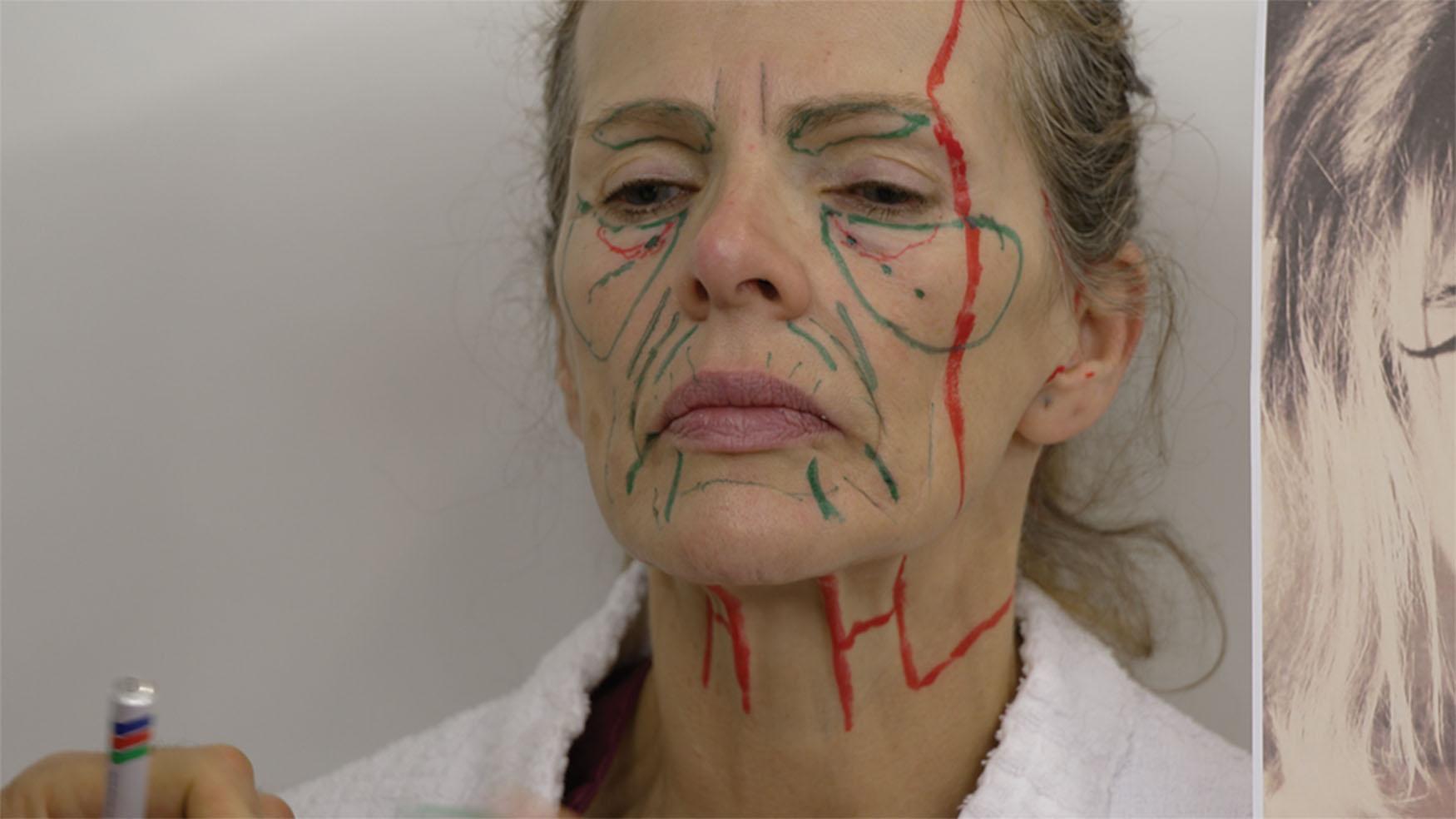
The skin marking is transferred onto the deeper layers by inserting two needles ( Fig. 9.4.23A,B ), between which the line is marked. The platysma is incised vertically at this line, and the dissection then continues subplatysmally, leaving the skin attached to platysma muscle. The subplatysmal dissection is carried on until beyond to the medial platysmal band. The anterior segment of the platysma is then transected through a subcutaneous tunnel, thus creating two skin–muscle composite flaps ( Figs. 9.4.24 & 9.4.25 ). These myocutaneous flaps are then suspended, the superior one towards the mastoid, and the inferior one posteriorly towards the sternocleidomastoid muscle ( Fig. 9.4.26 ).

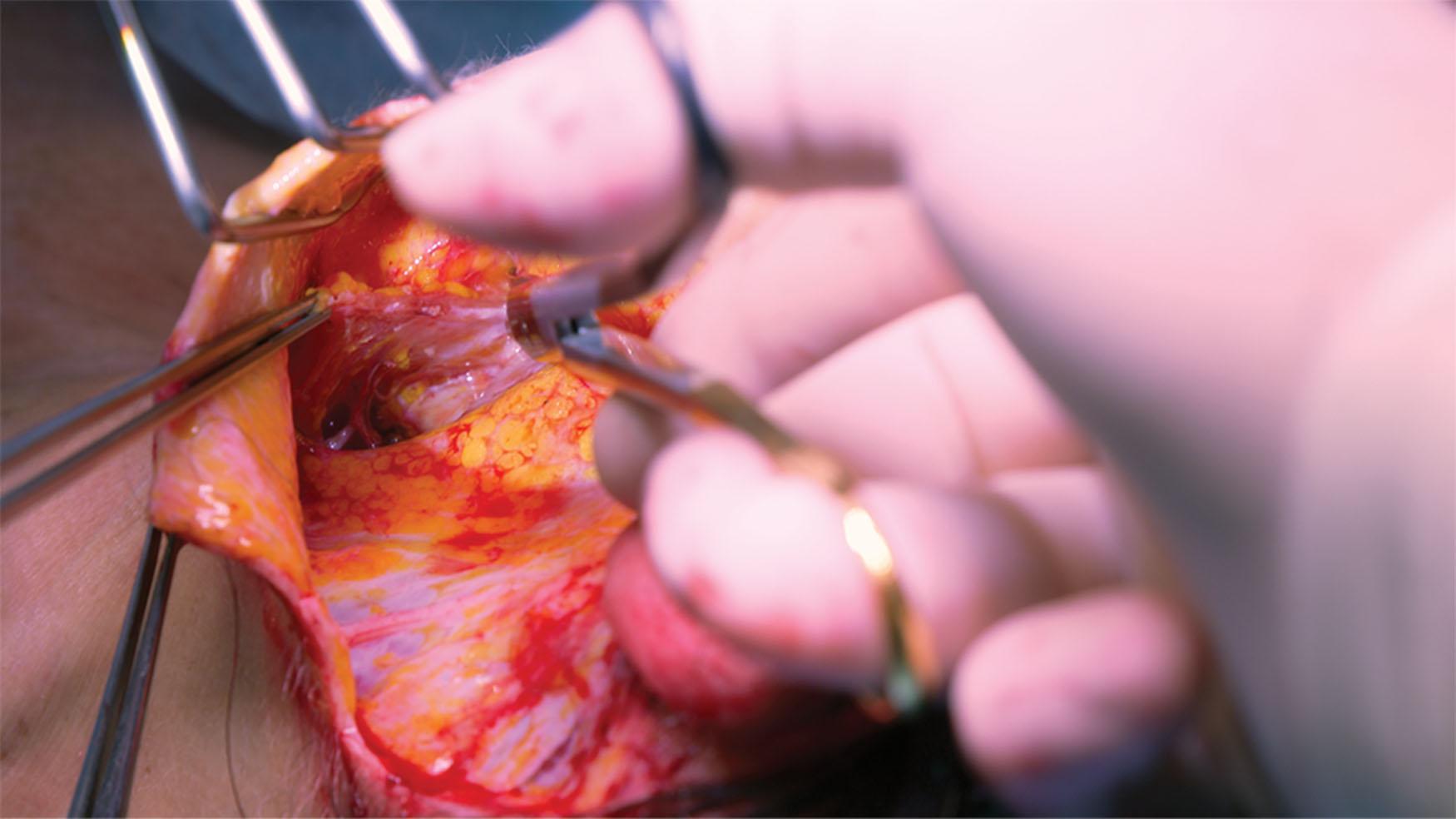
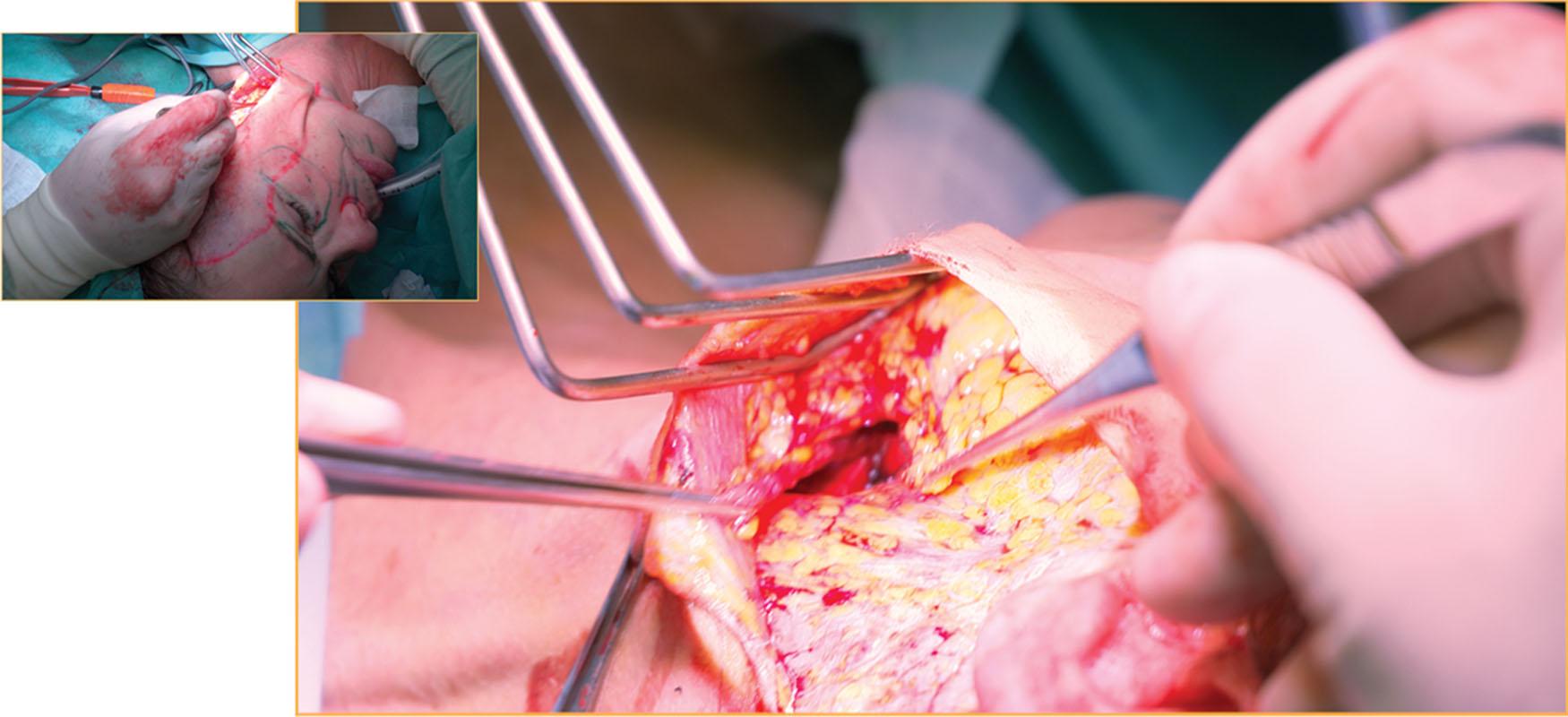
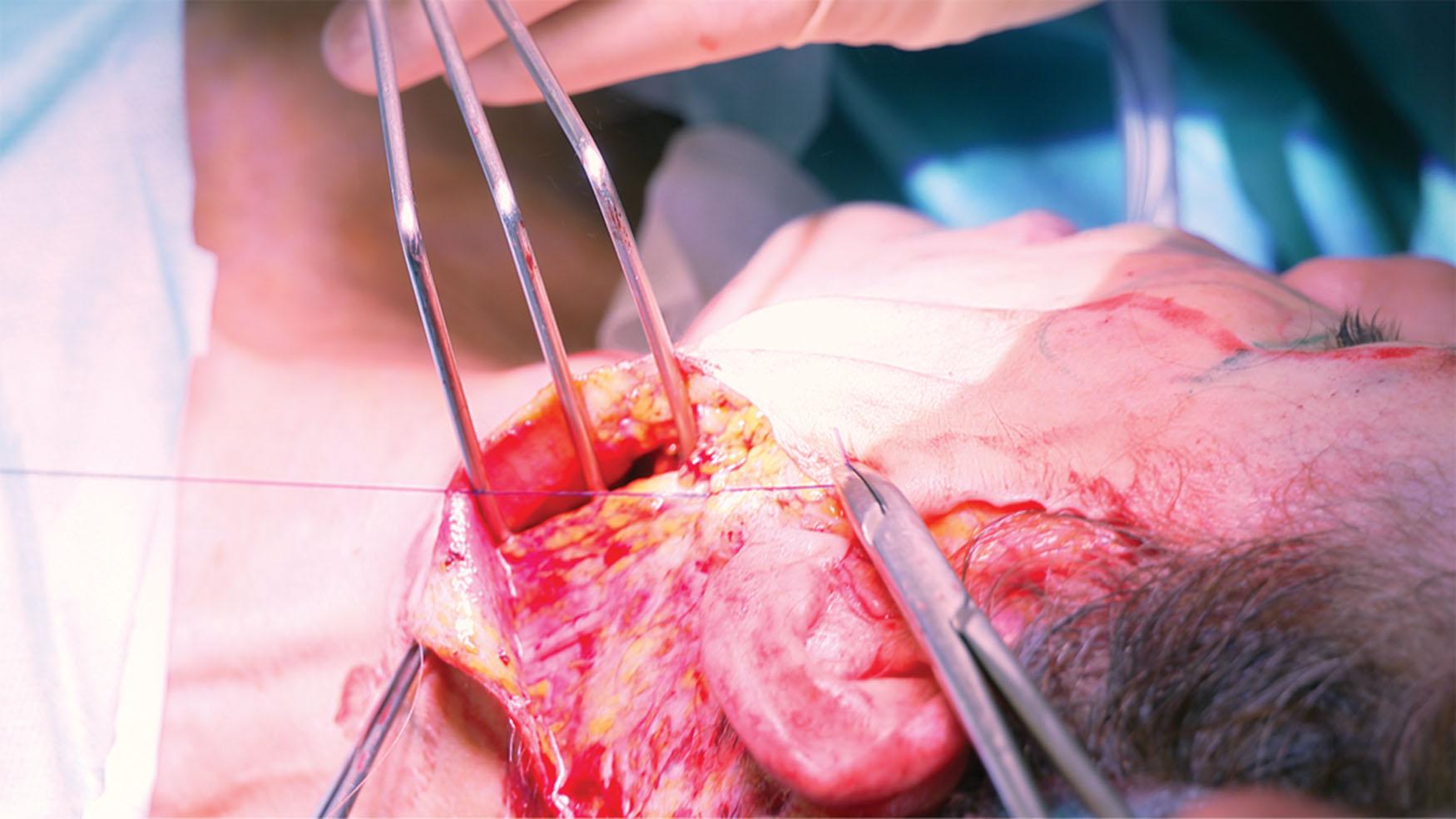
This procedure results in a very efficient correction and good definition of the cervicomental angle and also a powerful lateral suspension of the lower neck region.
Resection of a ptotic or hypertrophied submandibular gland can be easily done through this lateral approach if needed, making the need for an additional submental incision unnecessary.
The MACS lift is a pure vertical vector facelift procedure. As a consequence of cranial shifting of facial soft tissues a paracanthal skin excess can occur, which may accentuate a pre-existing temporal hooding. If temporal hooding is detected when evaluating the patient for facial rejuvenation, or a paracanthal bulging of skin is detected during the MACS lift procedure, the addition of a temporal lifting procedure is needed ( Fig. 9.4.27 ). The paracanthal and temporal skin is undermined in continuity with the MACS lift dissection ( Fig. 9.4.28 ) in order to redrape the skin and eliminate any folds. This method also allows an effective lifting of the lateral brow to its ideal position. The skin and brow is then fixated in its new position by the Auersvald hemostatic net (A-net) described above. This procedure is actually a modification of a gliding brow lift technique, described by Fausto Viterbo (see section Internal browpexy and temporal lift, below).
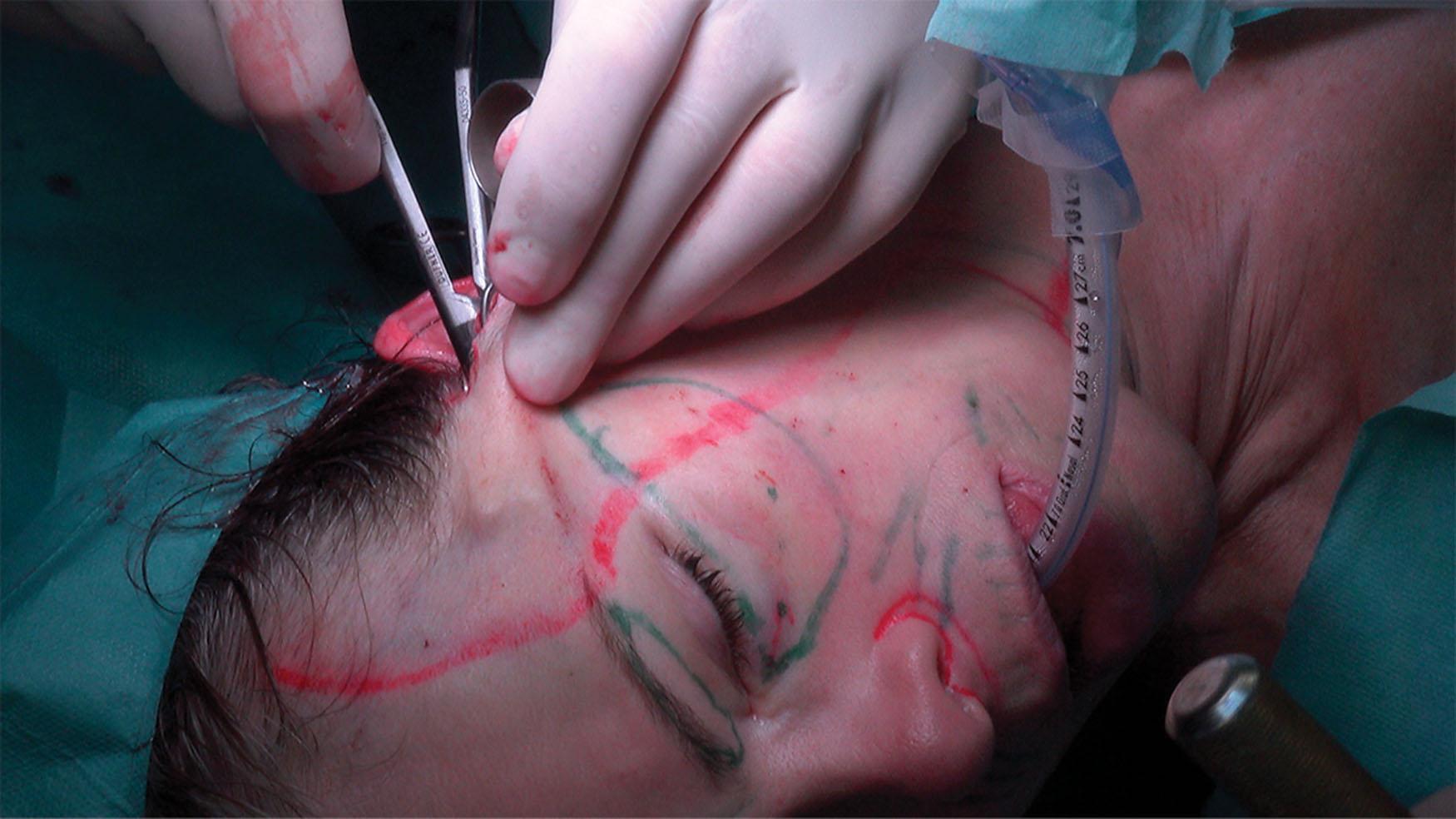

The periorbital area together with the perioral area are the source of facial emotional expression. Eye tracking studies have proven that when observing a face the eyes and the mouth of the subject are scanned in a triangular pattern, mostly skipping the peripheral areas of the face and neck.
Become a Clinical Tree membership for Full access and enjoy Unlimited articles
If you are a member. Log in here